Comparative Operations Management Report: Singapore Airlines & Flybe
VerifiedAdded on 2023/04/07
|19
|5001
|148
Report
AI Summary
This report examines the operations management strategies of Singapore Airlines and Flybe, focusing on approaches to improve employee performance and job satisfaction, service concepts, target customers, value chain analysis, and methods for measuring service quality and customer satisfaction. Key areas explored include motivation theory, training and development, performance appraisal, reward systems, and organizational culture to enhance employee performance. The report also discusses the service characteristics of the airline sector, emphasizing intangibility, variability, inseparability, and perishability. Furthermore, it analyzes how Singapore Airlines and Flybe utilize different marketing strategies and services to target various customer segments. The report concludes by highlighting the implications for the future operations of both airlines, emphasizing growth through innovative technologies and competitive advantages, and contribution to the GDP of their respective countries. Desklib provides this and many more solved assignments for students.
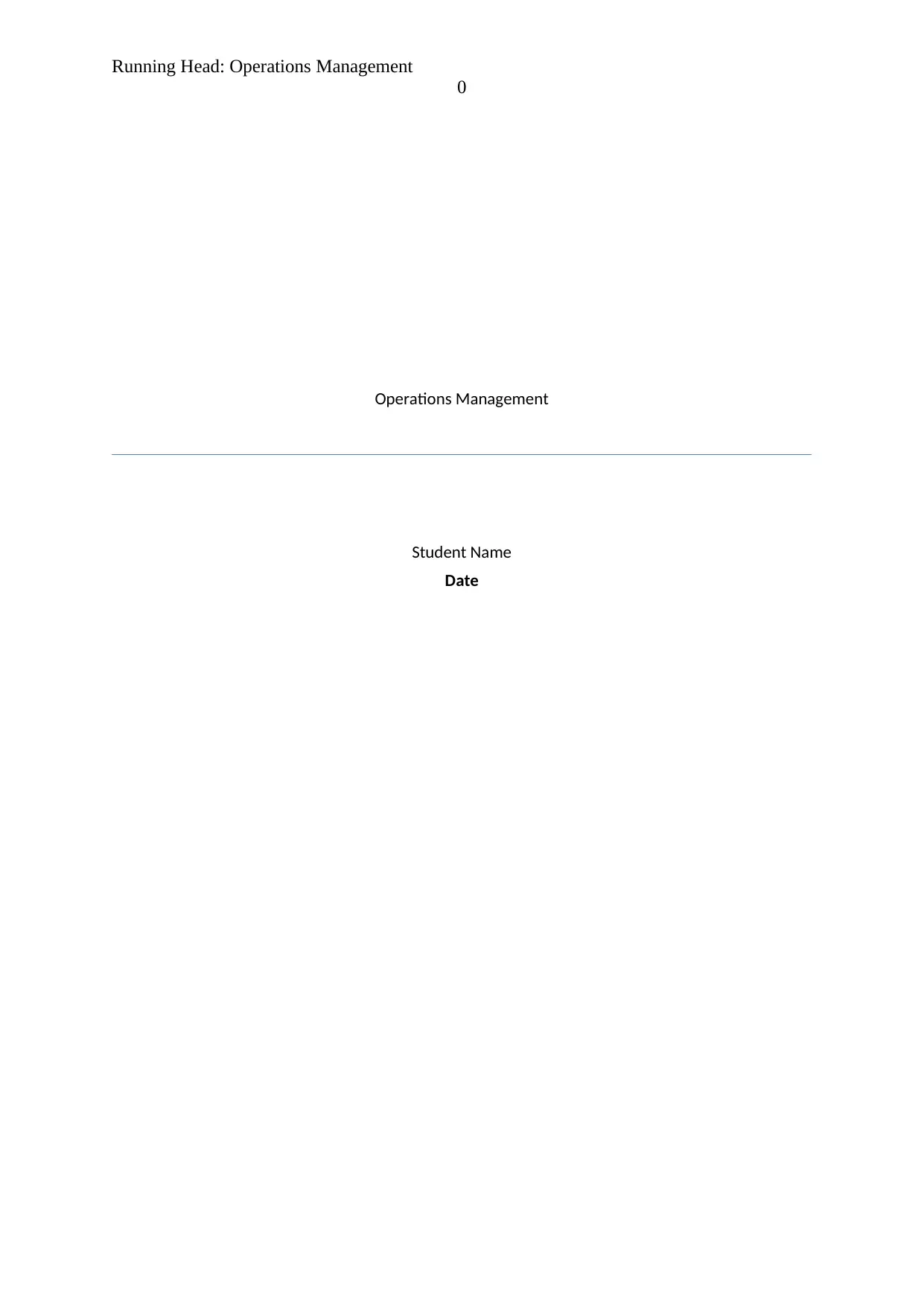
Running Head: Operations Management
0
Operations Management
Student Name
Date
0
Operations Management
Student Name
Date
Secure Best Marks with AI Grader
Need help grading? Try our AI Grader for instant feedback on your assignments.
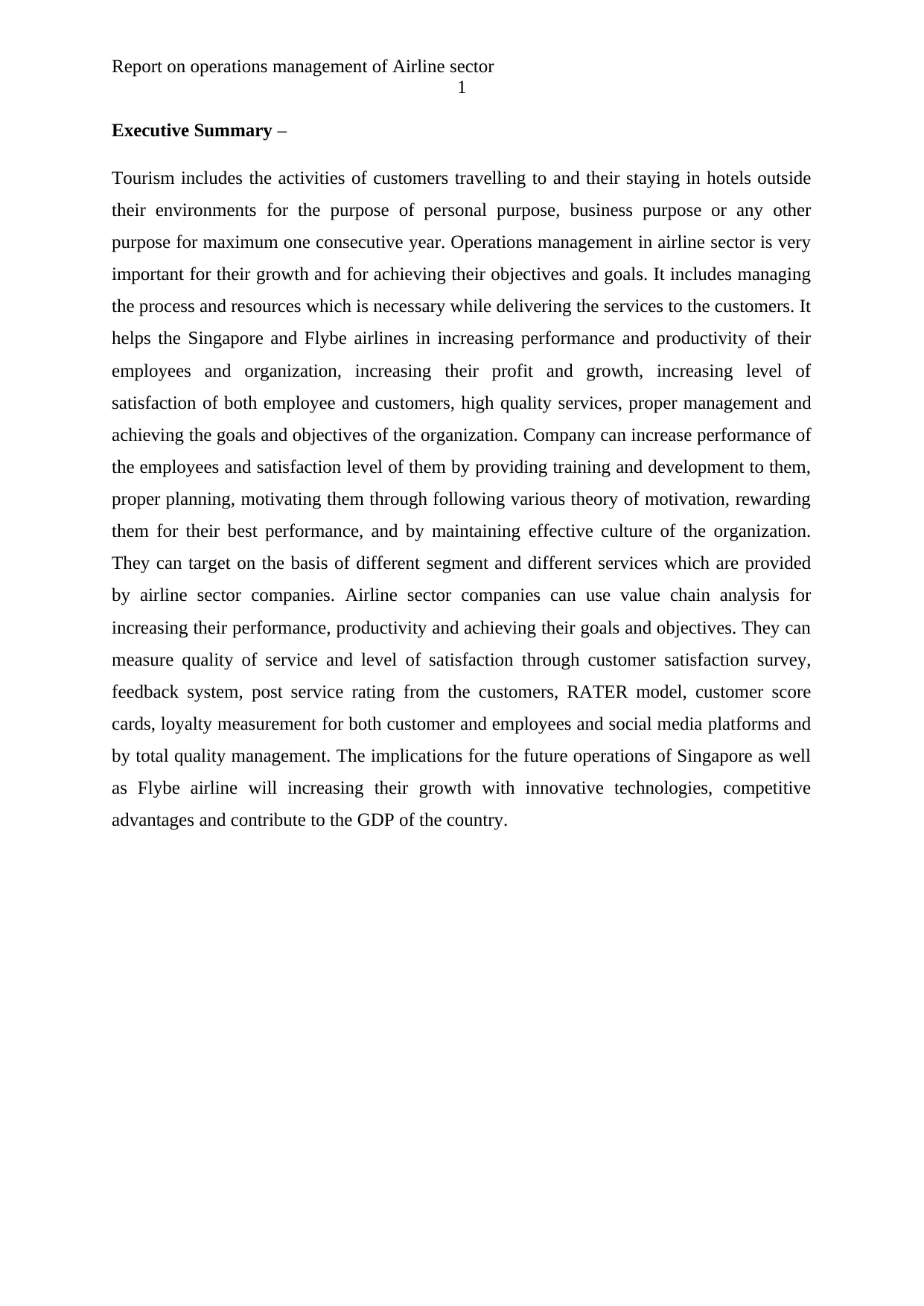
Report on operations management of Airline sector
1
Executive Summary –
Tourism includes the activities of customers travelling to and their staying in hotels outside
their environments for the purpose of personal purpose, business purpose or any other
purpose for maximum one consecutive year. Operations management in airline sector is very
important for their growth and for achieving their objectives and goals. It includes managing
the process and resources which is necessary while delivering the services to the customers. It
helps the Singapore and Flybe airlines in increasing performance and productivity of their
employees and organization, increasing their profit and growth, increasing level of
satisfaction of both employee and customers, high quality services, proper management and
achieving the goals and objectives of the organization. Company can increase performance of
the employees and satisfaction level of them by providing training and development to them,
proper planning, motivating them through following various theory of motivation, rewarding
them for their best performance, and by maintaining effective culture of the organization.
They can target on the basis of different segment and different services which are provided
by airline sector companies. Airline sector companies can use value chain analysis for
increasing their performance, productivity and achieving their goals and objectives. They can
measure quality of service and level of satisfaction through customer satisfaction survey,
feedback system, post service rating from the customers, RATER model, customer score
cards, loyalty measurement for both customer and employees and social media platforms and
by total quality management. The implications for the future operations of Singapore as well
as Flybe airline will increasing their growth with innovative technologies, competitive
advantages and contribute to the GDP of the country.
1
Executive Summary –
Tourism includes the activities of customers travelling to and their staying in hotels outside
their environments for the purpose of personal purpose, business purpose or any other
purpose for maximum one consecutive year. Operations management in airline sector is very
important for their growth and for achieving their objectives and goals. It includes managing
the process and resources which is necessary while delivering the services to the customers. It
helps the Singapore and Flybe airlines in increasing performance and productivity of their
employees and organization, increasing their profit and growth, increasing level of
satisfaction of both employee and customers, high quality services, proper management and
achieving the goals and objectives of the organization. Company can increase performance of
the employees and satisfaction level of them by providing training and development to them,
proper planning, motivating them through following various theory of motivation, rewarding
them for their best performance, and by maintaining effective culture of the organization.
They can target on the basis of different segment and different services which are provided
by airline sector companies. Airline sector companies can use value chain analysis for
increasing their performance, productivity and achieving their goals and objectives. They can
measure quality of service and level of satisfaction through customer satisfaction survey,
feedback system, post service rating from the customers, RATER model, customer score
cards, loyalty measurement for both customer and employees and social media platforms and
by total quality management. The implications for the future operations of Singapore as well
as Flybe airline will increasing their growth with innovative technologies, competitive
advantages and contribute to the GDP of the country.
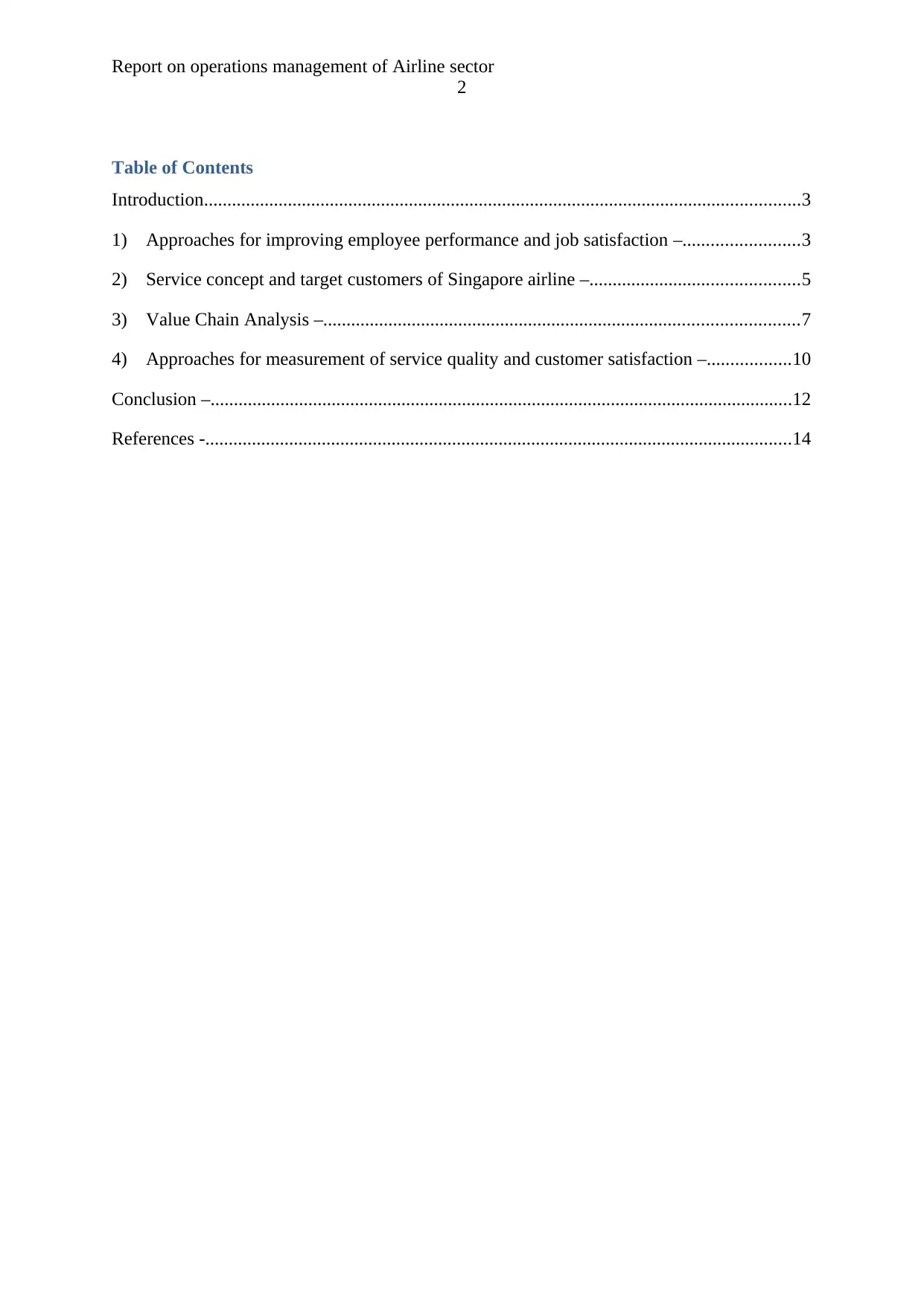
Report on operations management of Airline sector
2
Table of Contents
Introduction................................................................................................................................3
1) Approaches for improving employee performance and job satisfaction –.........................3
2) Service concept and target customers of Singapore airline –.............................................5
3) Value Chain Analysis –......................................................................................................7
4) Approaches for measurement of service quality and customer satisfaction –..................10
Conclusion –.............................................................................................................................12
References -..............................................................................................................................14
2
Table of Contents
Introduction................................................................................................................................3
1) Approaches for improving employee performance and job satisfaction –.........................3
2) Service concept and target customers of Singapore airline –.............................................5
3) Value Chain Analysis –......................................................................................................7
4) Approaches for measurement of service quality and customer satisfaction –..................10
Conclusion –.............................................................................................................................12
References -..............................................................................................................................14
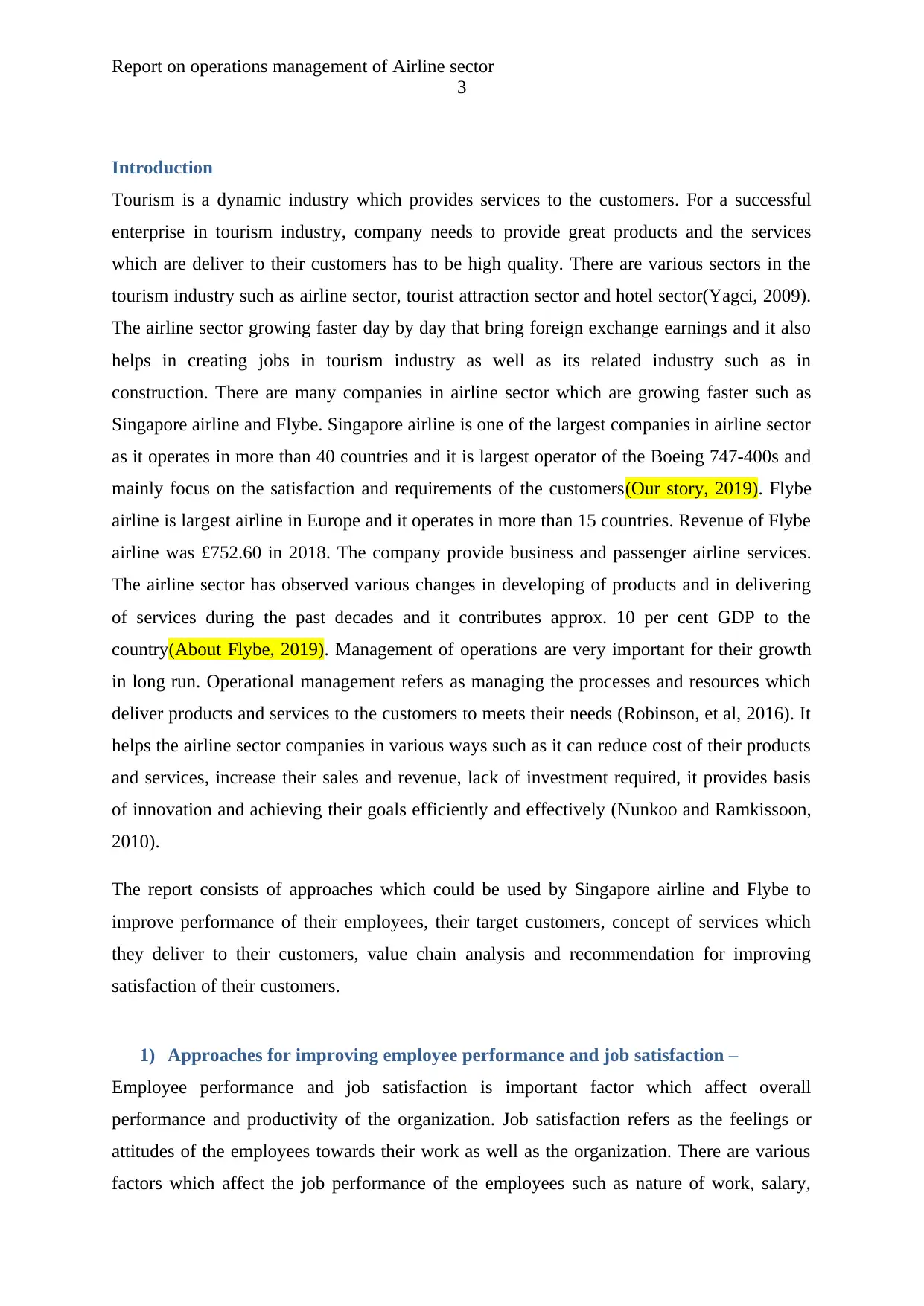
Report on operations management of Airline sector
3
Introduction
Tourism is a dynamic industry which provides services to the customers. For a successful
enterprise in tourism industry, company needs to provide great products and the services
which are deliver to their customers has to be high quality. There are various sectors in the
tourism industry such as airline sector, tourist attraction sector and hotel sector(Yagci, 2009).
The airline sector growing faster day by day that bring foreign exchange earnings and it also
helps in creating jobs in tourism industry as well as its related industry such as in
construction. There are many companies in airline sector which are growing faster such as
Singapore airline and Flybe. Singapore airline is one of the largest companies in airline sector
as it operates in more than 40 countries and it is largest operator of the Boeing 747-400s and
mainly focus on the satisfaction and requirements of the customers(Our story, 2019). Flybe
airline is largest airline in Europe and it operates in more than 15 countries. Revenue of Flybe
airline was £752.60 in 2018. The company provide business and passenger airline services.
The airline sector has observed various changes in developing of products and in delivering
of services during the past decades and it contributes approx. 10 per cent GDP to the
country(About Flybe, 2019). Management of operations are very important for their growth
in long run. Operational management refers as managing the processes and resources which
deliver products and services to the customers to meets their needs (Robinson, et al, 2016). It
helps the airline sector companies in various ways such as it can reduce cost of their products
and services, increase their sales and revenue, lack of investment required, it provides basis
of innovation and achieving their goals efficiently and effectively (Nunkoo and Ramkissoon,
2010).
The report consists of approaches which could be used by Singapore airline and Flybe to
improve performance of their employees, their target customers, concept of services which
they deliver to their customers, value chain analysis and recommendation for improving
satisfaction of their customers.
1) Approaches for improving employee performance and job satisfaction –
Employee performance and job satisfaction is important factor which affect overall
performance and productivity of the organization. Job satisfaction refers as the feelings or
attitudes of the employees towards their work as well as the organization. There are various
factors which affect the job performance of the employees such as nature of work, salary,
3
Introduction
Tourism is a dynamic industry which provides services to the customers. For a successful
enterprise in tourism industry, company needs to provide great products and the services
which are deliver to their customers has to be high quality. There are various sectors in the
tourism industry such as airline sector, tourist attraction sector and hotel sector(Yagci, 2009).
The airline sector growing faster day by day that bring foreign exchange earnings and it also
helps in creating jobs in tourism industry as well as its related industry such as in
construction. There are many companies in airline sector which are growing faster such as
Singapore airline and Flybe. Singapore airline is one of the largest companies in airline sector
as it operates in more than 40 countries and it is largest operator of the Boeing 747-400s and
mainly focus on the satisfaction and requirements of the customers(Our story, 2019). Flybe
airline is largest airline in Europe and it operates in more than 15 countries. Revenue of Flybe
airline was £752.60 in 2018. The company provide business and passenger airline services.
The airline sector has observed various changes in developing of products and in delivering
of services during the past decades and it contributes approx. 10 per cent GDP to the
country(About Flybe, 2019). Management of operations are very important for their growth
in long run. Operational management refers as managing the processes and resources which
deliver products and services to the customers to meets their needs (Robinson, et al, 2016). It
helps the airline sector companies in various ways such as it can reduce cost of their products
and services, increase their sales and revenue, lack of investment required, it provides basis
of innovation and achieving their goals efficiently and effectively (Nunkoo and Ramkissoon,
2010).
The report consists of approaches which could be used by Singapore airline and Flybe to
improve performance of their employees, their target customers, concept of services which
they deliver to their customers, value chain analysis and recommendation for improving
satisfaction of their customers.
1) Approaches for improving employee performance and job satisfaction –
Employee performance and job satisfaction is important factor which affect overall
performance and productivity of the organization. Job satisfaction refers as the feelings or
attitudes of the employees towards their work as well as the organization. There are various
factors which affect the job performance of the employees such as nature of work, salary,
Secure Best Marks with AI Grader
Need help grading? Try our AI Grader for instant feedback on your assignments.
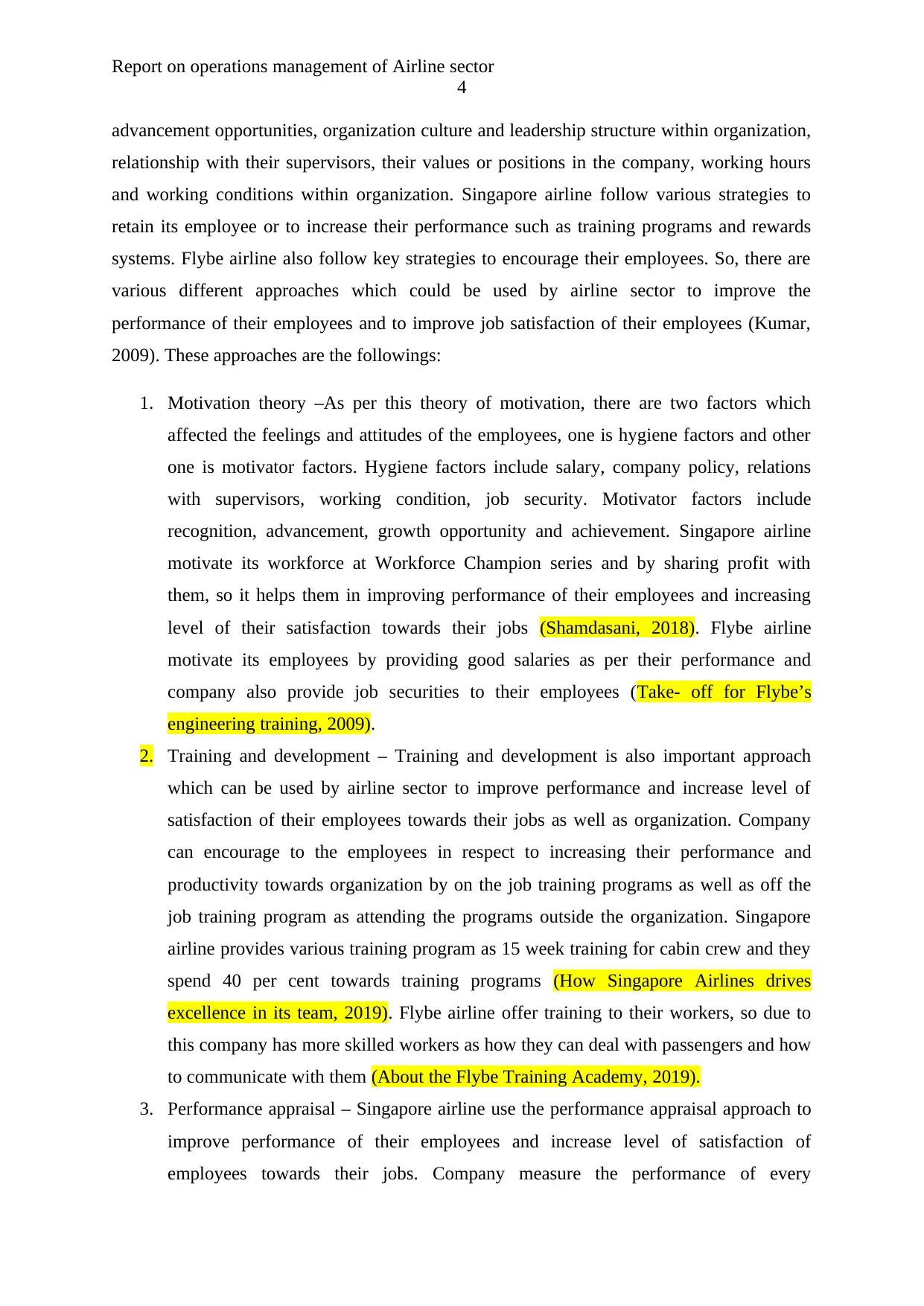
Report on operations management of Airline sector
4
advancement opportunities, organization culture and leadership structure within organization,
relationship with their supervisors, their values or positions in the company, working hours
and working conditions within organization. Singapore airline follow various strategies to
retain its employee or to increase their performance such as training programs and rewards
systems. Flybe airline also follow key strategies to encourage their employees. So, there are
various different approaches which could be used by airline sector to improve the
performance of their employees and to improve job satisfaction of their employees (Kumar,
2009). These approaches are the followings:
1. Motivation theory –As per this theory of motivation, there are two factors which
affected the feelings and attitudes of the employees, one is hygiene factors and other
one is motivator factors. Hygiene factors include salary, company policy, relations
with supervisors, working condition, job security. Motivator factors include
recognition, advancement, growth opportunity and achievement. Singapore airline
motivate its workforce at Workforce Champion series and by sharing profit with
them, so it helps them in improving performance of their employees and increasing
level of their satisfaction towards their jobs (Shamdasani, 2018). Flybe airline
motivate its employees by providing good salaries as per their performance and
company also provide job securities to their employees (Take- off for Flybe’s
engineering training, 2009).
2. Training and development – Training and development is also important approach
which can be used by airline sector to improve performance and increase level of
satisfaction of their employees towards their jobs as well as organization. Company
can encourage to the employees in respect to increasing their performance and
productivity towards organization by on the job training programs as well as off the
job training program as attending the programs outside the organization. Singapore
airline provides various training program as 15 week training for cabin crew and they
spend 40 per cent towards training programs (How Singapore Airlines drives
excellence in its team, 2019). Flybe airline offer training to their workers, so due to
this company has more skilled workers as how they can deal with passengers and how
to communicate with them (About the Flybe Training Academy, 2019).
3. Performance appraisal – Singapore airline use the performance appraisal approach to
improve performance of their employees and increase level of satisfaction of
employees towards their jobs. Company measure the performance of every
4
advancement opportunities, organization culture and leadership structure within organization,
relationship with their supervisors, their values or positions in the company, working hours
and working conditions within organization. Singapore airline follow various strategies to
retain its employee or to increase their performance such as training programs and rewards
systems. Flybe airline also follow key strategies to encourage their employees. So, there are
various different approaches which could be used by airline sector to improve the
performance of their employees and to improve job satisfaction of their employees (Kumar,
2009). These approaches are the followings:
1. Motivation theory –As per this theory of motivation, there are two factors which
affected the feelings and attitudes of the employees, one is hygiene factors and other
one is motivator factors. Hygiene factors include salary, company policy, relations
with supervisors, working condition, job security. Motivator factors include
recognition, advancement, growth opportunity and achievement. Singapore airline
motivate its workforce at Workforce Champion series and by sharing profit with
them, so it helps them in improving performance of their employees and increasing
level of their satisfaction towards their jobs (Shamdasani, 2018). Flybe airline
motivate its employees by providing good salaries as per their performance and
company also provide job securities to their employees (Take- off for Flybe’s
engineering training, 2009).
2. Training and development – Training and development is also important approach
which can be used by airline sector to improve performance and increase level of
satisfaction of their employees towards their jobs as well as organization. Company
can encourage to the employees in respect to increasing their performance and
productivity towards organization by on the job training programs as well as off the
job training program as attending the programs outside the organization. Singapore
airline provides various training program as 15 week training for cabin crew and they
spend 40 per cent towards training programs (How Singapore Airlines drives
excellence in its team, 2019). Flybe airline offer training to their workers, so due to
this company has more skilled workers as how they can deal with passengers and how
to communicate with them (About the Flybe Training Academy, 2019).
3. Performance appraisal – Singapore airline use the performance appraisal approach to
improve performance of their employees and increase level of satisfaction of
employees towards their jobs. Company measure the performance of every
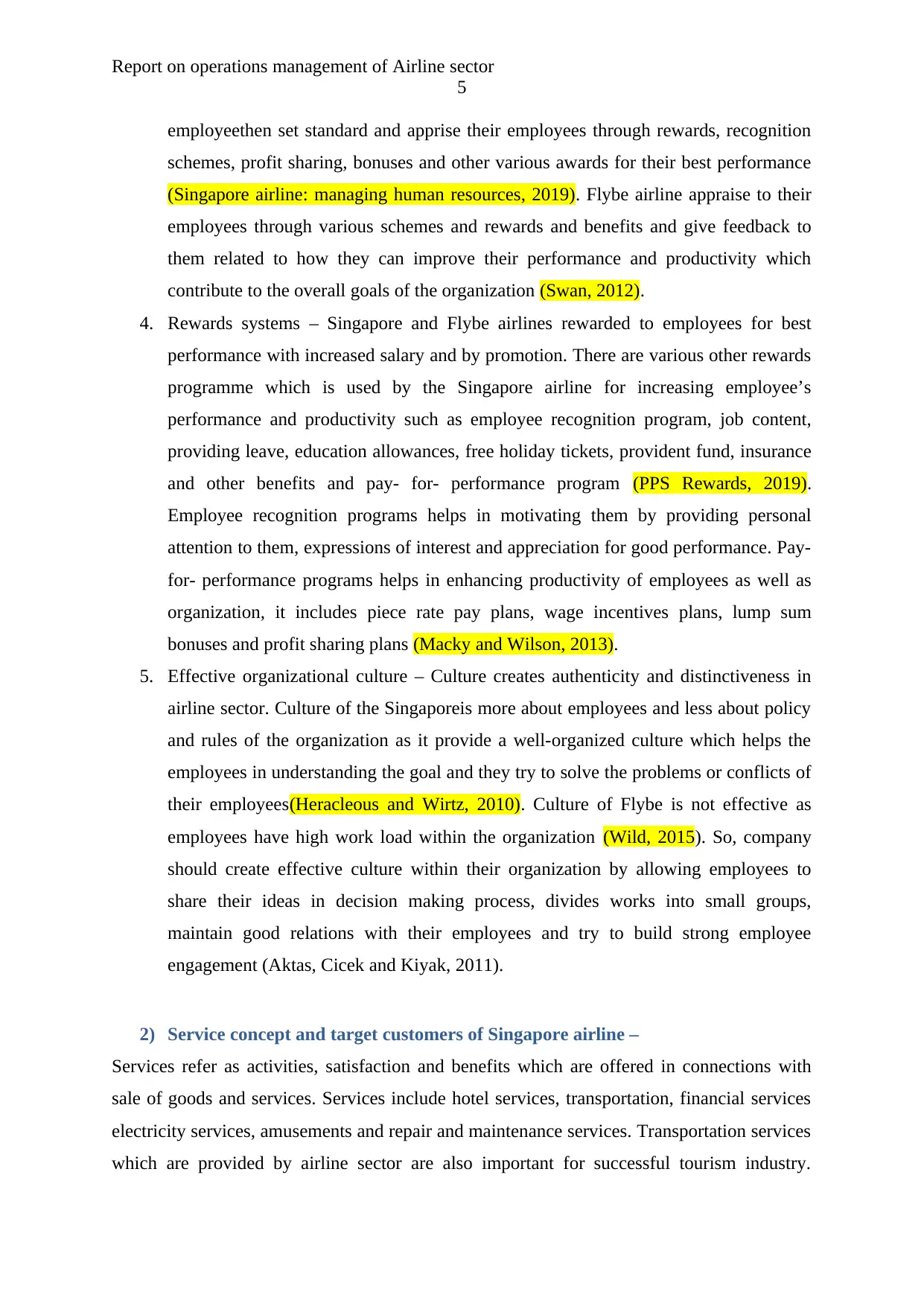
Report on operations management of Airline sector
5
employeethen set standard and apprise their employees through rewards, recognition
schemes, profit sharing, bonuses and other various awards for their best performance
(Singapore airline: managing human resources, 2019). Flybe airline appraise to their
employees through various schemes and rewards and benefits and give feedback to
them related to how they can improve their performance and productivity which
contribute to the overall goals of the organization (Swan, 2012).
4. Rewards systems – Singapore and Flybe airlines rewarded to employees for best
performance with increased salary and by promotion. There are various other rewards
programme which is used by the Singapore airline for increasing employee’s
performance and productivity such as employee recognition program, job content,
providing leave, education allowances, free holiday tickets, provident fund, insurance
and other benefits and pay- for- performance program (PPS Rewards, 2019).
Employee recognition programs helps in motivating them by providing personal
attention to them, expressions of interest and appreciation for good performance. Pay-
for- performance programs helps in enhancing productivity of employees as well as
organization, it includes piece rate pay plans, wage incentives plans, lump sum
bonuses and profit sharing plans (Macky and Wilson, 2013).
5. Effective organizational culture – Culture creates authenticity and distinctiveness in
airline sector. Culture of the Singaporeis more about employees and less about policy
and rules of the organization as it provide a well-organized culture which helps the
employees in understanding the goal and they try to solve the problems or conflicts of
their employees(Heracleous and Wirtz, 2010). Culture of Flybe is not effective as
employees have high work load within the organization (Wild, 2015). So, company
should create effective culture within their organization by allowing employees to
share their ideas in decision making process, divides works into small groups,
maintain good relations with their employees and try to build strong employee
engagement (Aktas, Cicek and Kiyak, 2011).
2) Service concept and target customers of Singapore airline –
Services refer as activities, satisfaction and benefits which are offered in connections with
sale of goods and services. Services include hotel services, transportation, financial services
electricity services, amusements and repair and maintenance services. Transportation services
which are provided by airline sector are also important for successful tourism industry.
5
employeethen set standard and apprise their employees through rewards, recognition
schemes, profit sharing, bonuses and other various awards for their best performance
(Singapore airline: managing human resources, 2019). Flybe airline appraise to their
employees through various schemes and rewards and benefits and give feedback to
them related to how they can improve their performance and productivity which
contribute to the overall goals of the organization (Swan, 2012).
4. Rewards systems – Singapore and Flybe airlines rewarded to employees for best
performance with increased salary and by promotion. There are various other rewards
programme which is used by the Singapore airline for increasing employee’s
performance and productivity such as employee recognition program, job content,
providing leave, education allowances, free holiday tickets, provident fund, insurance
and other benefits and pay- for- performance program (PPS Rewards, 2019).
Employee recognition programs helps in motivating them by providing personal
attention to them, expressions of interest and appreciation for good performance. Pay-
for- performance programs helps in enhancing productivity of employees as well as
organization, it includes piece rate pay plans, wage incentives plans, lump sum
bonuses and profit sharing plans (Macky and Wilson, 2013).
5. Effective organizational culture – Culture creates authenticity and distinctiveness in
airline sector. Culture of the Singaporeis more about employees and less about policy
and rules of the organization as it provide a well-organized culture which helps the
employees in understanding the goal and they try to solve the problems or conflicts of
their employees(Heracleous and Wirtz, 2010). Culture of Flybe is not effective as
employees have high work load within the organization (Wild, 2015). So, company
should create effective culture within their organization by allowing employees to
share their ideas in decision making process, divides works into small groups,
maintain good relations with their employees and try to build strong employee
engagement (Aktas, Cicek and Kiyak, 2011).
2) Service concept and target customers of Singapore airline –
Services refer as activities, satisfaction and benefits which are offered in connections with
sale of goods and services. Services include hotel services, transportation, financial services
electricity services, amusements and repair and maintenance services. Transportation services
which are provided by airline sector are also important for successful tourism industry.
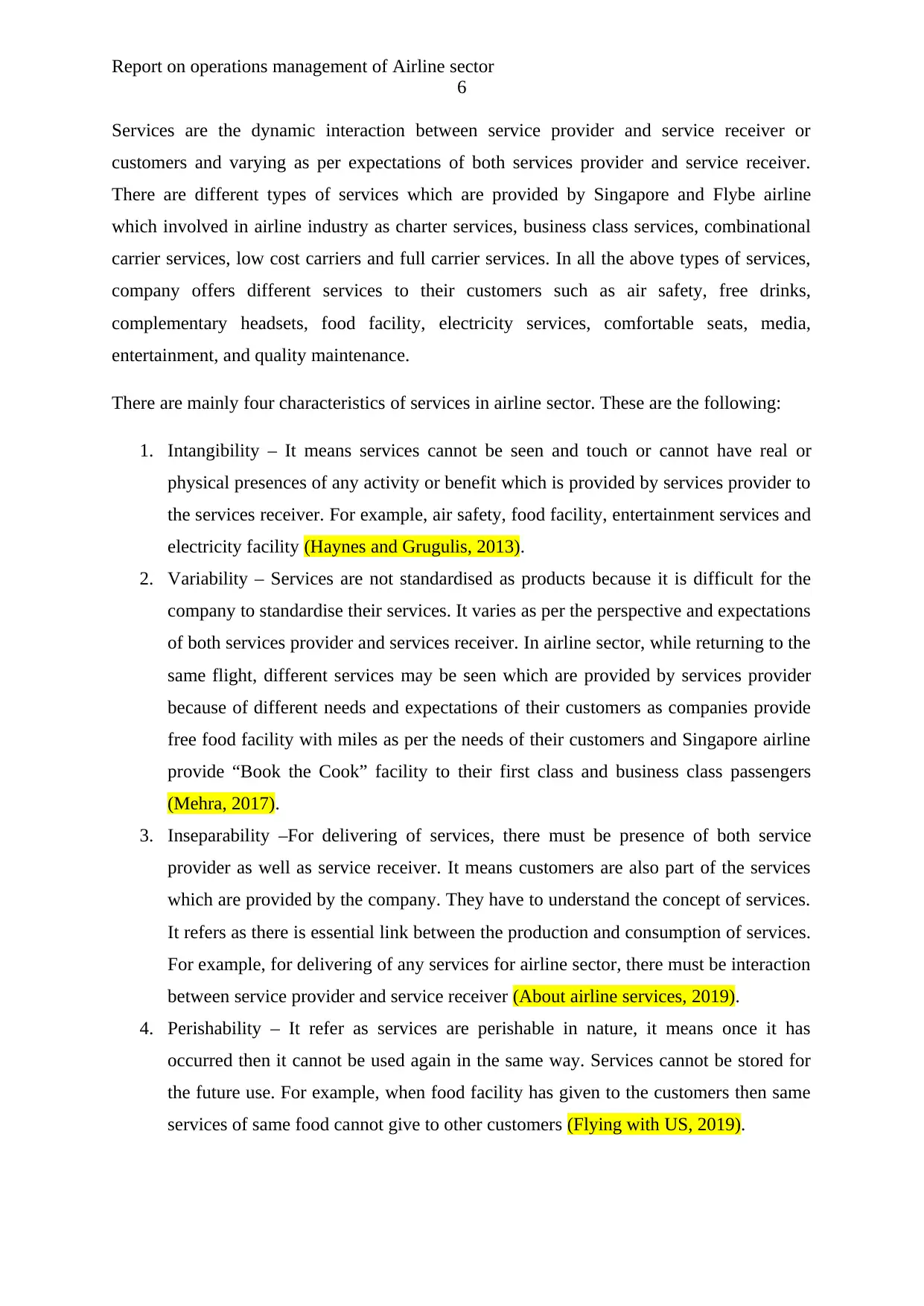
Report on operations management of Airline sector
6
Services are the dynamic interaction between service provider and service receiver or
customers and varying as per expectations of both services provider and service receiver.
There are different types of services which are provided by Singapore and Flybe airline
which involved in airline industry as charter services, business class services, combinational
carrier services, low cost carriers and full carrier services. In all the above types of services,
company offers different services to their customers such as air safety, free drinks,
complementary headsets, food facility, electricity services, comfortable seats, media,
entertainment, and quality maintenance.
There are mainly four characteristics of services in airline sector. These are the following:
1. Intangibility – It means services cannot be seen and touch or cannot have real or
physical presences of any activity or benefit which is provided by services provider to
the services receiver. For example, air safety, food facility, entertainment services and
electricity facility (Haynes and Grugulis, 2013).
2. Variability – Services are not standardised as products because it is difficult for the
company to standardise their services. It varies as per the perspective and expectations
of both services provider and services receiver. In airline sector, while returning to the
same flight, different services may be seen which are provided by services provider
because of different needs and expectations of their customers as companies provide
free food facility with miles as per the needs of their customers and Singapore airline
provide “Book the Cook” facility to their first class and business class passengers
(Mehra, 2017).
3. Inseparability –For delivering of services, there must be presence of both service
provider as well as service receiver. It means customers are also part of the services
which are provided by the company. They have to understand the concept of services.
It refers as there is essential link between the production and consumption of services.
For example, for delivering of any services for airline sector, there must be interaction
between service provider and service receiver (About airline services, 2019).
4. Perishability – It refer as services are perishable in nature, it means once it has
occurred then it cannot be used again in the same way. Services cannot be stored for
the future use. For example, when food facility has given to the customers then same
services of same food cannot give to other customers (Flying with US, 2019).
6
Services are the dynamic interaction between service provider and service receiver or
customers and varying as per expectations of both services provider and service receiver.
There are different types of services which are provided by Singapore and Flybe airline
which involved in airline industry as charter services, business class services, combinational
carrier services, low cost carriers and full carrier services. In all the above types of services,
company offers different services to their customers such as air safety, free drinks,
complementary headsets, food facility, electricity services, comfortable seats, media,
entertainment, and quality maintenance.
There are mainly four characteristics of services in airline sector. These are the following:
1. Intangibility – It means services cannot be seen and touch or cannot have real or
physical presences of any activity or benefit which is provided by services provider to
the services receiver. For example, air safety, food facility, entertainment services and
electricity facility (Haynes and Grugulis, 2013).
2. Variability – Services are not standardised as products because it is difficult for the
company to standardise their services. It varies as per the perspective and expectations
of both services provider and services receiver. In airline sector, while returning to the
same flight, different services may be seen which are provided by services provider
because of different needs and expectations of their customers as companies provide
free food facility with miles as per the needs of their customers and Singapore airline
provide “Book the Cook” facility to their first class and business class passengers
(Mehra, 2017).
3. Inseparability –For delivering of services, there must be presence of both service
provider as well as service receiver. It means customers are also part of the services
which are provided by the company. They have to understand the concept of services.
It refers as there is essential link between the production and consumption of services.
For example, for delivering of any services for airline sector, there must be interaction
between service provider and service receiver (About airline services, 2019).
4. Perishability – It refer as services are perishable in nature, it means once it has
occurred then it cannot be used again in the same way. Services cannot be stored for
the future use. For example, when food facility has given to the customers then same
services of same food cannot give to other customers (Flying with US, 2019).
Paraphrase This Document
Need a fresh take? Get an instant paraphrase of this document with our AI Paraphraser
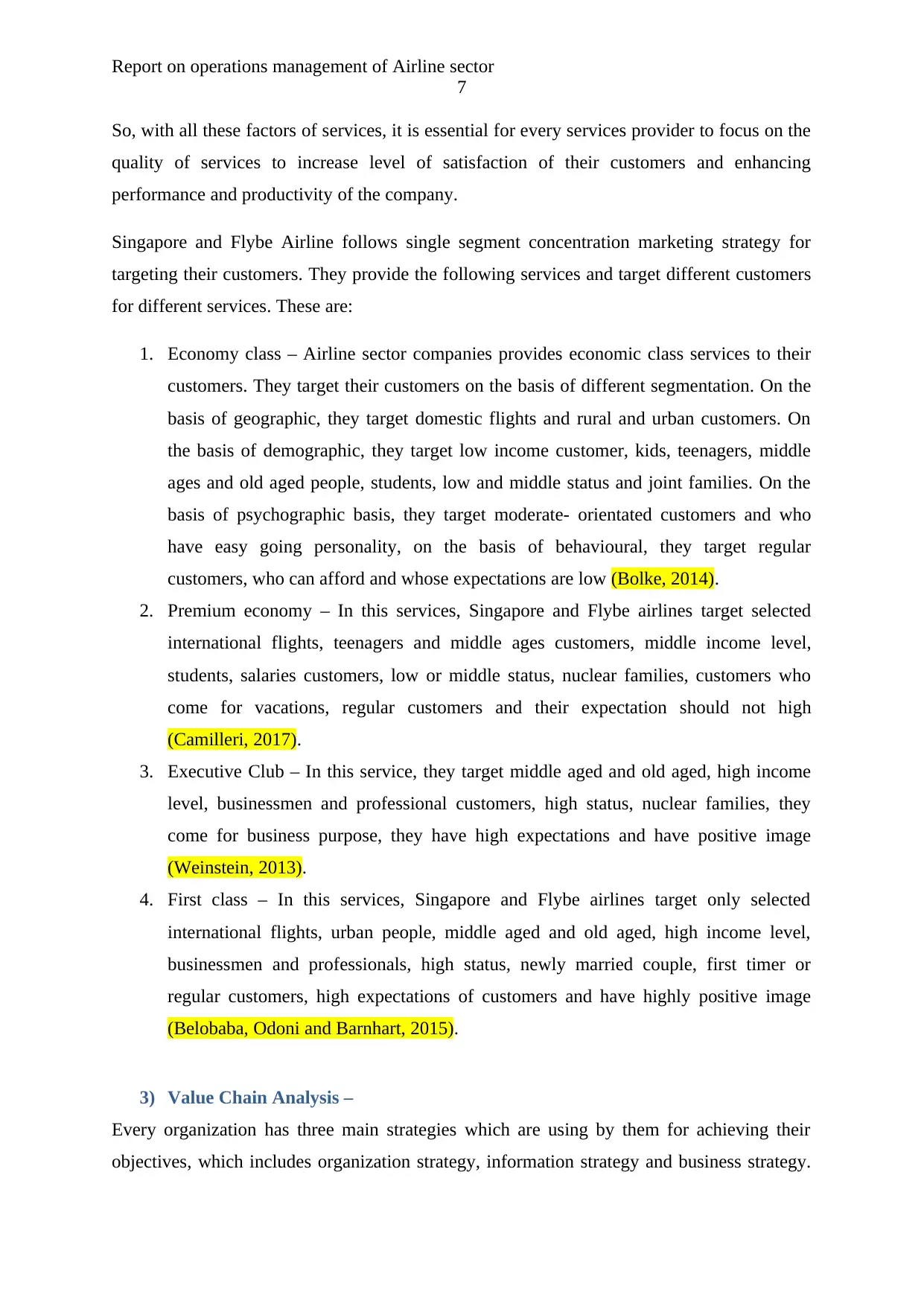
Report on operations management of Airline sector
7
So, with all these factors of services, it is essential for every services provider to focus on the
quality of services to increase level of satisfaction of their customers and enhancing
performance and productivity of the company.
Singapore and Flybe Airline follows single segment concentration marketing strategy for
targeting their customers. They provide the following services and target different customers
for different services. These are:
1. Economy class – Airline sector companies provides economic class services to their
customers. They target their customers on the basis of different segmentation. On the
basis of geographic, they target domestic flights and rural and urban customers. On
the basis of demographic, they target low income customer, kids, teenagers, middle
ages and old aged people, students, low and middle status and joint families. On the
basis of psychographic basis, they target moderate- orientated customers and who
have easy going personality, on the basis of behavioural, they target regular
customers, who can afford and whose expectations are low (Bolke, 2014).
2. Premium economy – In this services, Singapore and Flybe airlines target selected
international flights, teenagers and middle ages customers, middle income level,
students, salaries customers, low or middle status, nuclear families, customers who
come for vacations, regular customers and their expectation should not high
(Camilleri, 2017).
3. Executive Club – In this service, they target middle aged and old aged, high income
level, businessmen and professional customers, high status, nuclear families, they
come for business purpose, they have high expectations and have positive image
(Weinstein, 2013).
4. First class – In this services, Singapore and Flybe airlines target only selected
international flights, urban people, middle aged and old aged, high income level,
businessmen and professionals, high status, newly married couple, first timer or
regular customers, high expectations of customers and have highly positive image
(Belobaba, Odoni and Barnhart, 2015).
3) Value Chain Analysis –
Every organization has three main strategies which are using by them for achieving their
objectives, which includes organization strategy, information strategy and business strategy.
7
So, with all these factors of services, it is essential for every services provider to focus on the
quality of services to increase level of satisfaction of their customers and enhancing
performance and productivity of the company.
Singapore and Flybe Airline follows single segment concentration marketing strategy for
targeting their customers. They provide the following services and target different customers
for different services. These are:
1. Economy class – Airline sector companies provides economic class services to their
customers. They target their customers on the basis of different segmentation. On the
basis of geographic, they target domestic flights and rural and urban customers. On
the basis of demographic, they target low income customer, kids, teenagers, middle
ages and old aged people, students, low and middle status and joint families. On the
basis of psychographic basis, they target moderate- orientated customers and who
have easy going personality, on the basis of behavioural, they target regular
customers, who can afford and whose expectations are low (Bolke, 2014).
2. Premium economy – In this services, Singapore and Flybe airlines target selected
international flights, teenagers and middle ages customers, middle income level,
students, salaries customers, low or middle status, nuclear families, customers who
come for vacations, regular customers and their expectation should not high
(Camilleri, 2017).
3. Executive Club – In this service, they target middle aged and old aged, high income
level, businessmen and professional customers, high status, nuclear families, they
come for business purpose, they have high expectations and have positive image
(Weinstein, 2013).
4. First class – In this services, Singapore and Flybe airlines target only selected
international flights, urban people, middle aged and old aged, high income level,
businessmen and professionals, high status, newly married couple, first timer or
regular customers, high expectations of customers and have highly positive image
(Belobaba, Odoni and Barnhart, 2015).
3) Value Chain Analysis –
Every organization has three main strategies which are using by them for achieving their
objectives, which includes organization strategy, information strategy and business strategy.
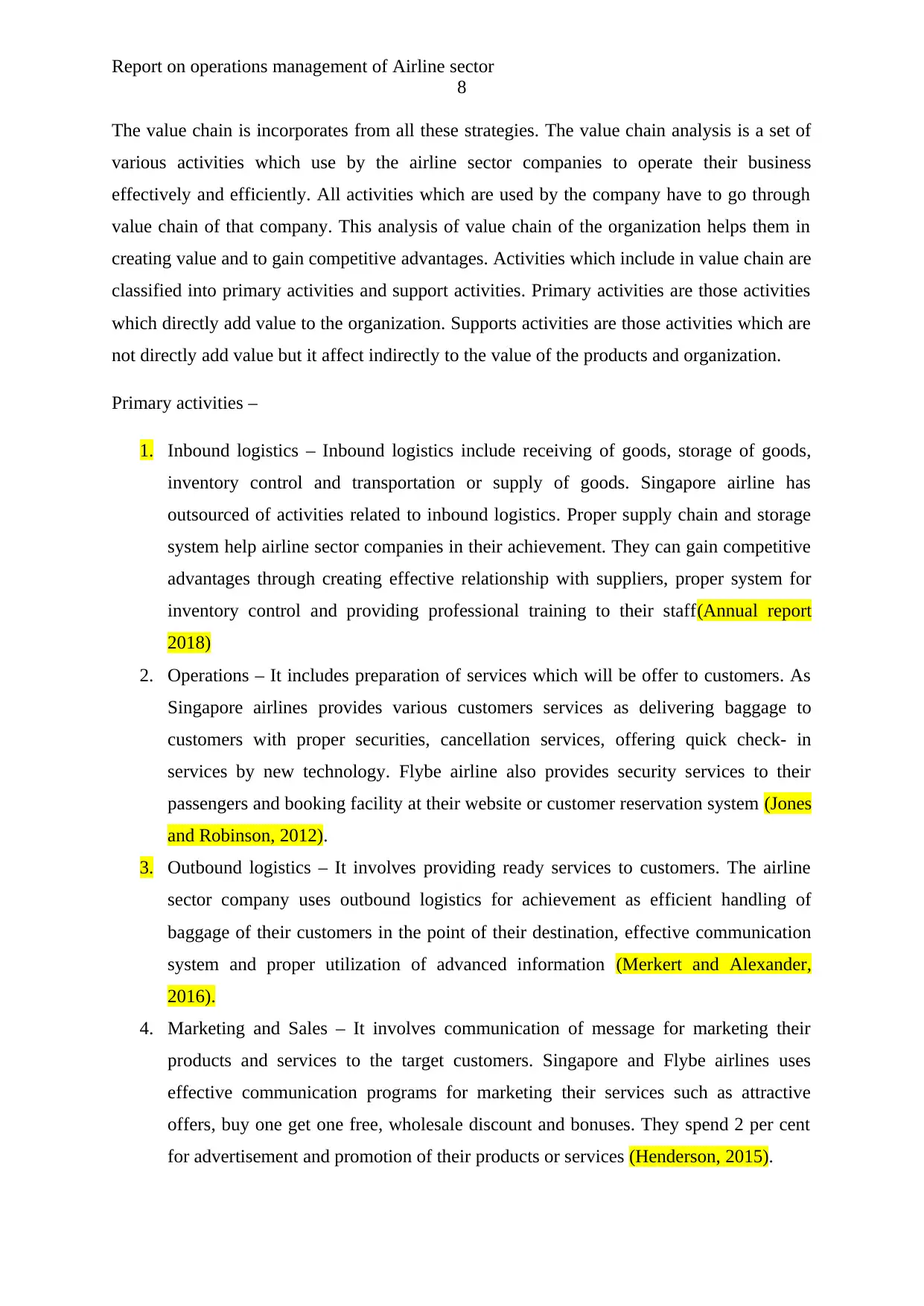
Report on operations management of Airline sector
8
The value chain is incorporates from all these strategies. The value chain analysis is a set of
various activities which use by the airline sector companies to operate their business
effectively and efficiently. All activities which are used by the company have to go through
value chain of that company. This analysis of value chain of the organization helps them in
creating value and to gain competitive advantages. Activities which include in value chain are
classified into primary activities and support activities. Primary activities are those activities
which directly add value to the organization. Supports activities are those activities which are
not directly add value but it affect indirectly to the value of the products and organization.
Primary activities –
1. Inbound logistics – Inbound logistics include receiving of goods, storage of goods,
inventory control and transportation or supply of goods. Singapore airline has
outsourced of activities related to inbound logistics. Proper supply chain and storage
system help airline sector companies in their achievement. They can gain competitive
advantages through creating effective relationship with suppliers, proper system for
inventory control and providing professional training to their staff(Annual report
2018)
2. Operations – It includes preparation of services which will be offer to customers. As
Singapore airlines provides various customers services as delivering baggage to
customers with proper securities, cancellation services, offering quick check- in
services by new technology. Flybe airline also provides security services to their
passengers and booking facility at their website or customer reservation system (Jones
and Robinson, 2012).
3. Outbound logistics – It involves providing ready services to customers. The airline
sector company uses outbound logistics for achievement as efficient handling of
baggage of their customers in the point of their destination, effective communication
system and proper utilization of advanced information (Merkert and Alexander,
2016).
4. Marketing and Sales – It involves communication of message for marketing their
products and services to the target customers. Singapore and Flybe airlines uses
effective communication programs for marketing their services such as attractive
offers, buy one get one free, wholesale discount and bonuses. They spend 2 per cent
for advertisement and promotion of their products or services (Henderson, 2015).
8
The value chain is incorporates from all these strategies. The value chain analysis is a set of
various activities which use by the airline sector companies to operate their business
effectively and efficiently. All activities which are used by the company have to go through
value chain of that company. This analysis of value chain of the organization helps them in
creating value and to gain competitive advantages. Activities which include in value chain are
classified into primary activities and support activities. Primary activities are those activities
which directly add value to the organization. Supports activities are those activities which are
not directly add value but it affect indirectly to the value of the products and organization.
Primary activities –
1. Inbound logistics – Inbound logistics include receiving of goods, storage of goods,
inventory control and transportation or supply of goods. Singapore airline has
outsourced of activities related to inbound logistics. Proper supply chain and storage
system help airline sector companies in their achievement. They can gain competitive
advantages through creating effective relationship with suppliers, proper system for
inventory control and providing professional training to their staff(Annual report
2018)
2. Operations – It includes preparation of services which will be offer to customers. As
Singapore airlines provides various customers services as delivering baggage to
customers with proper securities, cancellation services, offering quick check- in
services by new technology. Flybe airline also provides security services to their
passengers and booking facility at their website or customer reservation system (Jones
and Robinson, 2012).
3. Outbound logistics – It involves providing ready services to customers. The airline
sector company uses outbound logistics for achievement as efficient handling of
baggage of their customers in the point of their destination, effective communication
system and proper utilization of advanced information (Merkert and Alexander,
2016).
4. Marketing and Sales – It involves communication of message for marketing their
products and services to the target customers. Singapore and Flybe airlines uses
effective communication programs for marketing their services such as attractive
offers, buy one get one free, wholesale discount and bonuses. They spend 2 per cent
for advertisement and promotion of their products or services (Henderson, 2015).
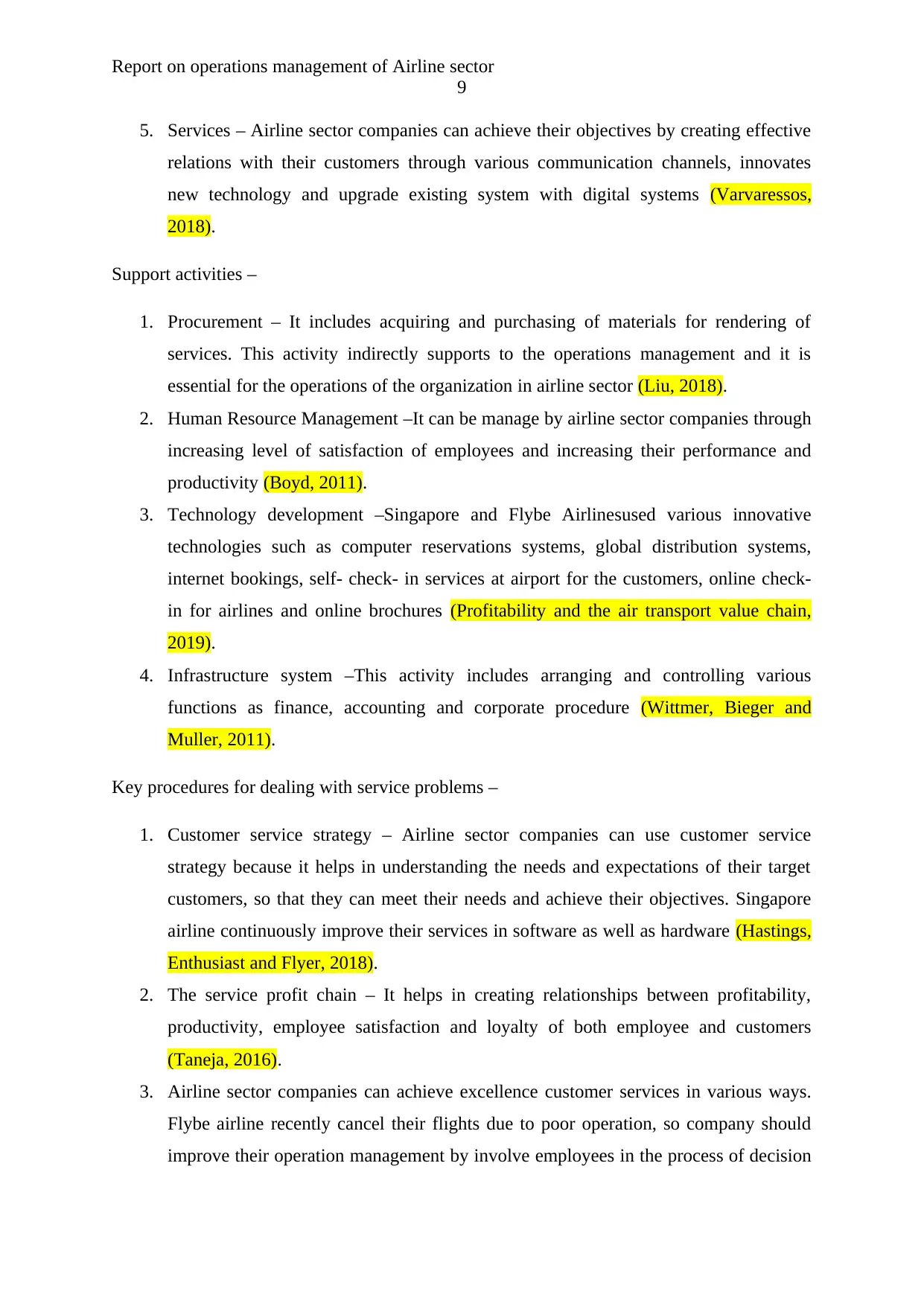
Report on operations management of Airline sector
9
5. Services – Airline sector companies can achieve their objectives by creating effective
relations with their customers through various communication channels, innovates
new technology and upgrade existing system with digital systems (Varvaressos,
2018).
Support activities –
1. Procurement – It includes acquiring and purchasing of materials for rendering of
services. This activity indirectly supports to the operations management and it is
essential for the operations of the organization in airline sector (Liu, 2018).
2. Human Resource Management –It can be manage by airline sector companies through
increasing level of satisfaction of employees and increasing their performance and
productivity (Boyd, 2011).
3. Technology development –Singapore and Flybe Airlinesused various innovative
technologies such as computer reservations systems, global distribution systems,
internet bookings, self- check- in services at airport for the customers, online check-
in for airlines and online brochures (Profitability and the air transport value chain,
2019).
4. Infrastructure system –This activity includes arranging and controlling various
functions as finance, accounting and corporate procedure (Wittmer, Bieger and
Muller, 2011).
Key procedures for dealing with service problems –
1. Customer service strategy – Airline sector companies can use customer service
strategy because it helps in understanding the needs and expectations of their target
customers, so that they can meet their needs and achieve their objectives. Singapore
airline continuously improve their services in software as well as hardware (Hastings,
Enthusiast and Flyer, 2018).
2. The service profit chain – It helps in creating relationships between profitability,
productivity, employee satisfaction and loyalty of both employee and customers
(Taneja, 2016).
3. Airline sector companies can achieve excellence customer services in various ways.
Flybe airline recently cancel their flights due to poor operation, so company should
improve their operation management by involve employees in the process of decision
9
5. Services – Airline sector companies can achieve their objectives by creating effective
relations with their customers through various communication channels, innovates
new technology and upgrade existing system with digital systems (Varvaressos,
2018).
Support activities –
1. Procurement – It includes acquiring and purchasing of materials for rendering of
services. This activity indirectly supports to the operations management and it is
essential for the operations of the organization in airline sector (Liu, 2018).
2. Human Resource Management –It can be manage by airline sector companies through
increasing level of satisfaction of employees and increasing their performance and
productivity (Boyd, 2011).
3. Technology development –Singapore and Flybe Airlinesused various innovative
technologies such as computer reservations systems, global distribution systems,
internet bookings, self- check- in services at airport for the customers, online check-
in for airlines and online brochures (Profitability and the air transport value chain,
2019).
4. Infrastructure system –This activity includes arranging and controlling various
functions as finance, accounting and corporate procedure (Wittmer, Bieger and
Muller, 2011).
Key procedures for dealing with service problems –
1. Customer service strategy – Airline sector companies can use customer service
strategy because it helps in understanding the needs and expectations of their target
customers, so that they can meet their needs and achieve their objectives. Singapore
airline continuously improve their services in software as well as hardware (Hastings,
Enthusiast and Flyer, 2018).
2. The service profit chain – It helps in creating relationships between profitability,
productivity, employee satisfaction and loyalty of both employee and customers
(Taneja, 2016).
3. Airline sector companies can achieve excellence customer services in various ways.
Flybe airline recently cancel their flights due to poor operation, so company should
improve their operation management by involve employees in the process of decision
Secure Best Marks with AI Grader
Need help grading? Try our AI Grader for instant feedback on your assignments.
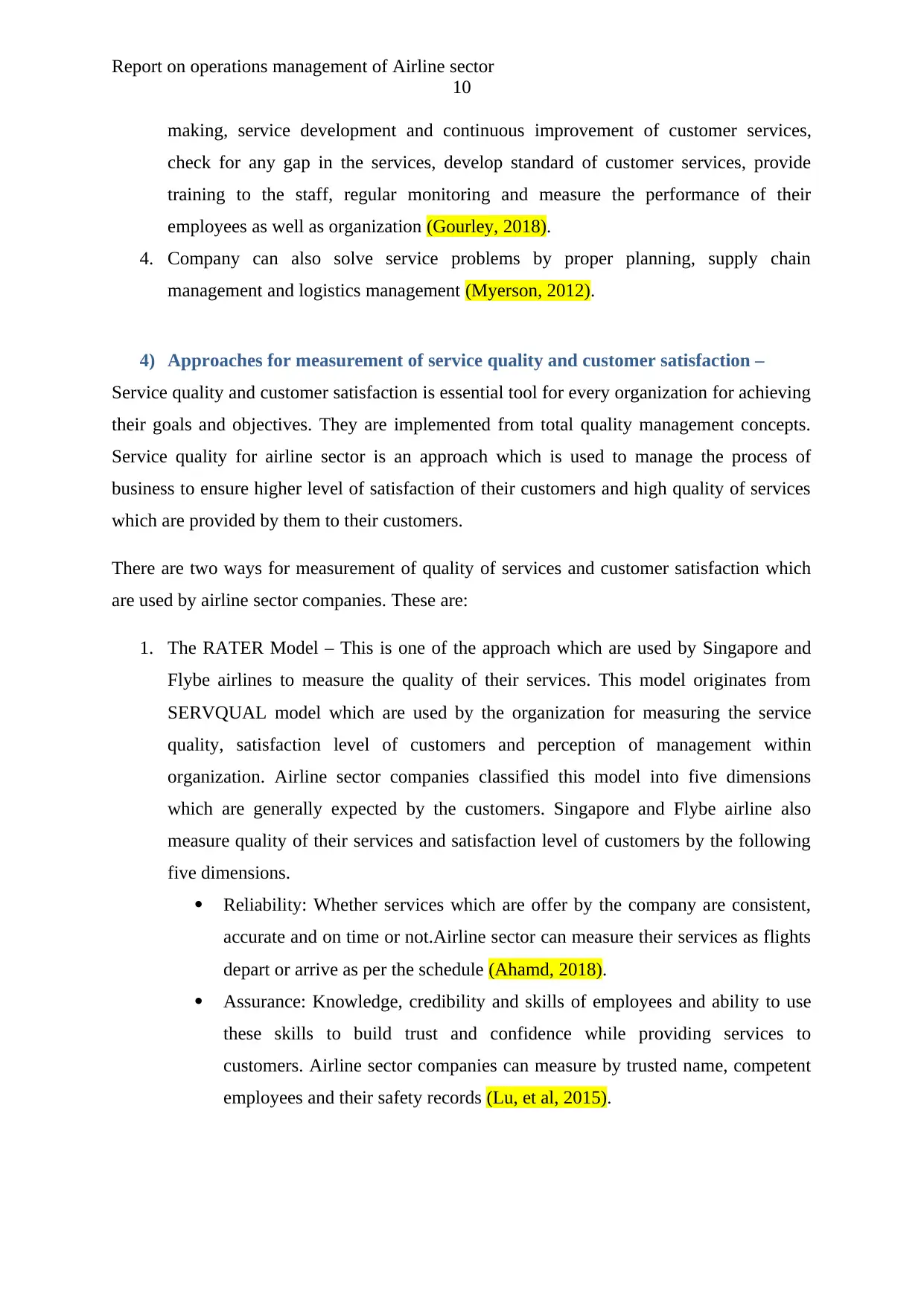
Report on operations management of Airline sector
10
making, service development and continuous improvement of customer services,
check for any gap in the services, develop standard of customer services, provide
training to the staff, regular monitoring and measure the performance of their
employees as well as organization (Gourley, 2018).
4. Company can also solve service problems by proper planning, supply chain
management and logistics management (Myerson, 2012).
4) Approaches for measurement of service quality and customer satisfaction –
Service quality and customer satisfaction is essential tool for every organization for achieving
their goals and objectives. They are implemented from total quality management concepts.
Service quality for airline sector is an approach which is used to manage the process of
business to ensure higher level of satisfaction of their customers and high quality of services
which are provided by them to their customers.
There are two ways for measurement of quality of services and customer satisfaction which
are used by airline sector companies. These are:
1. The RATER Model – This is one of the approach which are used by Singapore and
Flybe airlines to measure the quality of their services. This model originates from
SERVQUAL model which are used by the organization for measuring the service
quality, satisfaction level of customers and perception of management within
organization. Airline sector companies classified this model into five dimensions
which are generally expected by the customers. Singapore and Flybe airline also
measure quality of their services and satisfaction level of customers by the following
five dimensions.
Reliability: Whether services which are offer by the company are consistent,
accurate and on time or not.Airline sector can measure their services as flights
depart or arrive as per the schedule (Ahamd, 2018).
Assurance: Knowledge, credibility and skills of employees and ability to use
these skills to build trust and confidence while providing services to
customers. Airline sector companies can measure by trusted name, competent
employees and their safety records (Lu, et al, 2015).
10
making, service development and continuous improvement of customer services,
check for any gap in the services, develop standard of customer services, provide
training to the staff, regular monitoring and measure the performance of their
employees as well as organization (Gourley, 2018).
4. Company can also solve service problems by proper planning, supply chain
management and logistics management (Myerson, 2012).
4) Approaches for measurement of service quality and customer satisfaction –
Service quality and customer satisfaction is essential tool for every organization for achieving
their goals and objectives. They are implemented from total quality management concepts.
Service quality for airline sector is an approach which is used to manage the process of
business to ensure higher level of satisfaction of their customers and high quality of services
which are provided by them to their customers.
There are two ways for measurement of quality of services and customer satisfaction which
are used by airline sector companies. These are:
1. The RATER Model – This is one of the approach which are used by Singapore and
Flybe airlines to measure the quality of their services. This model originates from
SERVQUAL model which are used by the organization for measuring the service
quality, satisfaction level of customers and perception of management within
organization. Airline sector companies classified this model into five dimensions
which are generally expected by the customers. Singapore and Flybe airline also
measure quality of their services and satisfaction level of customers by the following
five dimensions.
Reliability: Whether services which are offer by the company are consistent,
accurate and on time or not.Airline sector can measure their services as flights
depart or arrive as per the schedule (Ahamd, 2018).
Assurance: Knowledge, credibility and skills of employees and ability to use
these skills to build trust and confidence while providing services to
customers. Airline sector companies can measure by trusted name, competent
employees and their safety records (Lu, et al, 2015).
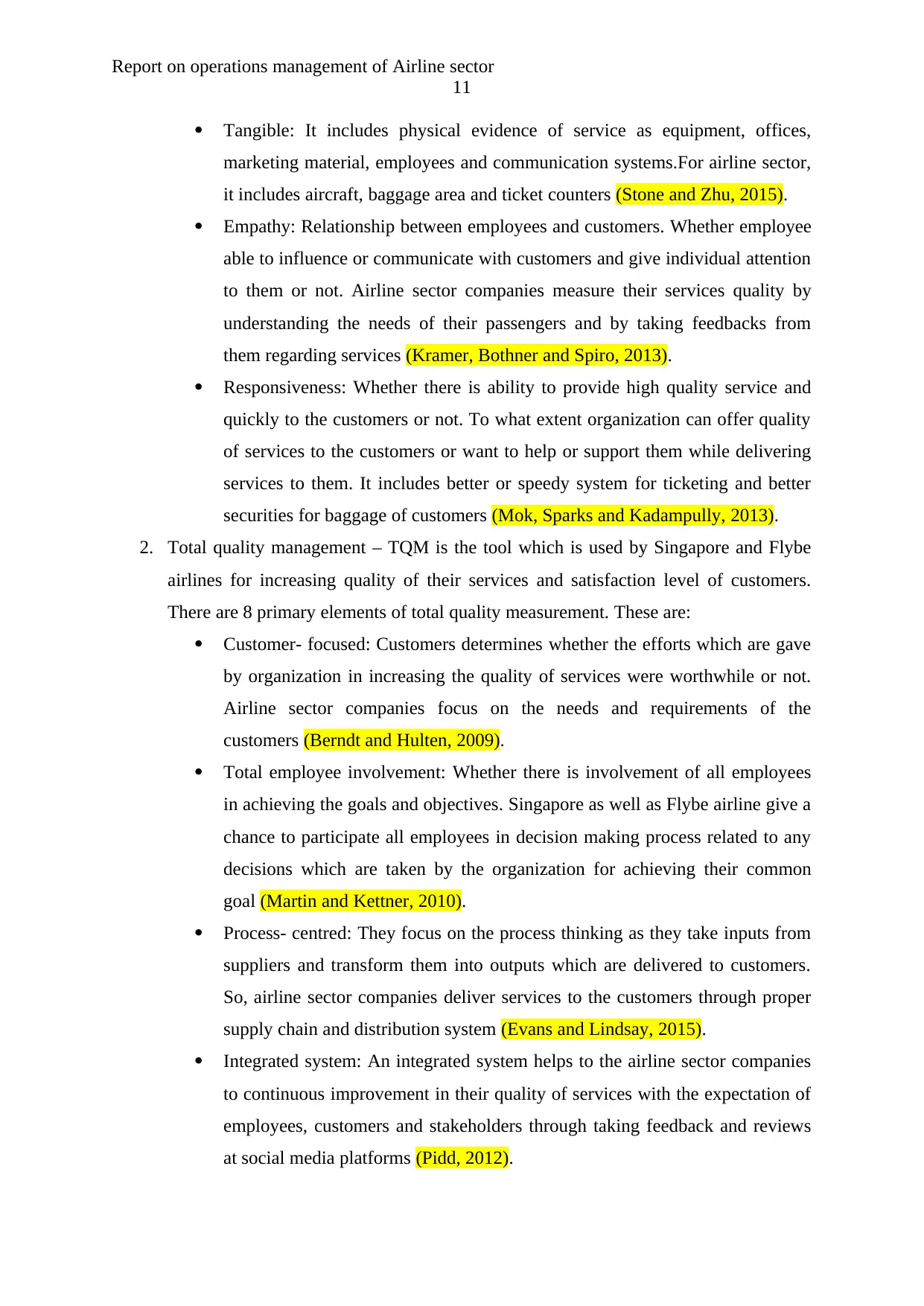
Report on operations management of Airline sector
11
Tangible: It includes physical evidence of service as equipment, offices,
marketing material, employees and communication systems.For airline sector,
it includes aircraft, baggage area and ticket counters (Stone and Zhu, 2015).
Empathy: Relationship between employees and customers. Whether employee
able to influence or communicate with customers and give individual attention
to them or not. Airline sector companies measure their services quality by
understanding the needs of their passengers and by taking feedbacks from
them regarding services (Kramer, Bothner and Spiro, 2013).
Responsiveness: Whether there is ability to provide high quality service and
quickly to the customers or not. To what extent organization can offer quality
of services to the customers or want to help or support them while delivering
services to them. It includes better or speedy system for ticketing and better
securities for baggage of customers (Mok, Sparks and Kadampully, 2013).
2. Total quality management – TQM is the tool which is used by Singapore and Flybe
airlines for increasing quality of their services and satisfaction level of customers.
There are 8 primary elements of total quality measurement. These are:
Customer- focused: Customers determines whether the efforts which are gave
by organization in increasing the quality of services were worthwhile or not.
Airline sector companies focus on the needs and requirements of the
customers (Berndt and Hulten, 2009).
Total employee involvement: Whether there is involvement of all employees
in achieving the goals and objectives. Singapore as well as Flybe airline give a
chance to participate all employees in decision making process related to any
decisions which are taken by the organization for achieving their common
goal (Martin and Kettner, 2010).
Process- centred: They focus on the process thinking as they take inputs from
suppliers and transform them into outputs which are delivered to customers.
So, airline sector companies deliver services to the customers through proper
supply chain and distribution system (Evans and Lindsay, 2015).
Integrated system: An integrated system helps to the airline sector companies
to continuous improvement in their quality of services with the expectation of
employees, customers and stakeholders through taking feedback and reviews
at social media platforms (Pidd, 2012).
11
Tangible: It includes physical evidence of service as equipment, offices,
marketing material, employees and communication systems.For airline sector,
it includes aircraft, baggage area and ticket counters (Stone and Zhu, 2015).
Empathy: Relationship between employees and customers. Whether employee
able to influence or communicate with customers and give individual attention
to them or not. Airline sector companies measure their services quality by
understanding the needs of their passengers and by taking feedbacks from
them regarding services (Kramer, Bothner and Spiro, 2013).
Responsiveness: Whether there is ability to provide high quality service and
quickly to the customers or not. To what extent organization can offer quality
of services to the customers or want to help or support them while delivering
services to them. It includes better or speedy system for ticketing and better
securities for baggage of customers (Mok, Sparks and Kadampully, 2013).
2. Total quality management – TQM is the tool which is used by Singapore and Flybe
airlines for increasing quality of their services and satisfaction level of customers.
There are 8 primary elements of total quality measurement. These are:
Customer- focused: Customers determines whether the efforts which are gave
by organization in increasing the quality of services were worthwhile or not.
Airline sector companies focus on the needs and requirements of the
customers (Berndt and Hulten, 2009).
Total employee involvement: Whether there is involvement of all employees
in achieving the goals and objectives. Singapore as well as Flybe airline give a
chance to participate all employees in decision making process related to any
decisions which are taken by the organization for achieving their common
goal (Martin and Kettner, 2010).
Process- centred: They focus on the process thinking as they take inputs from
suppliers and transform them into outputs which are delivered to customers.
So, airline sector companies deliver services to the customers through proper
supply chain and distribution system (Evans and Lindsay, 2015).
Integrated system: An integrated system helps to the airline sector companies
to continuous improvement in their quality of services with the expectation of
employees, customers and stakeholders through taking feedback and reviews
at social media platforms (Pidd, 2012).
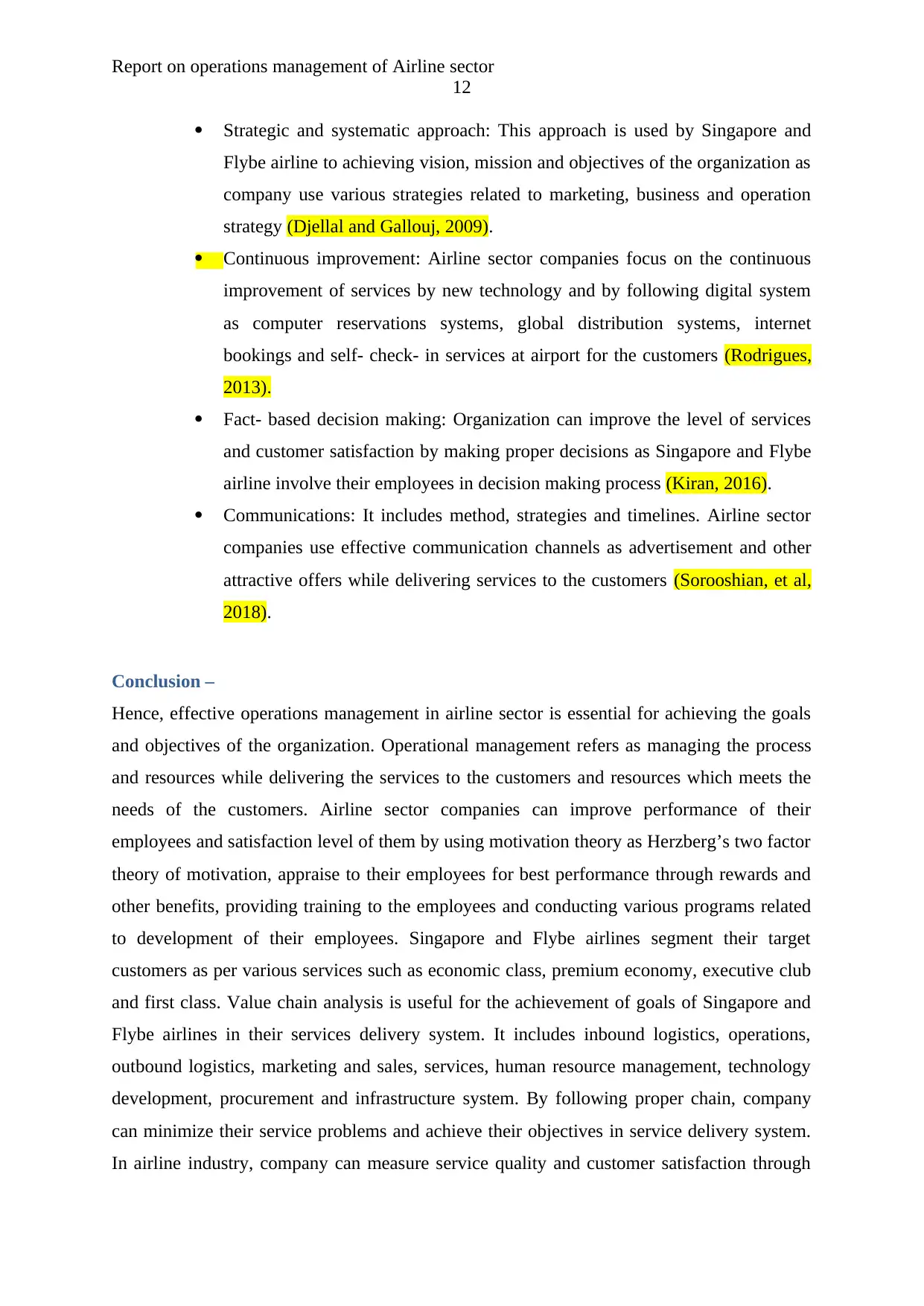
Report on operations management of Airline sector
12
Strategic and systematic approach: This approach is used by Singapore and
Flybe airline to achieving vision, mission and objectives of the organization as
company use various strategies related to marketing, business and operation
strategy (Djellal and Gallouj, 2009).
Continuous improvement: Airline sector companies focus on the continuous
improvement of services by new technology and by following digital system
as computer reservations systems, global distribution systems, internet
bookings and self- check- in services at airport for the customers (Rodrigues,
2013).
Fact- based decision making: Organization can improve the level of services
and customer satisfaction by making proper decisions as Singapore and Flybe
airline involve their employees in decision making process (Kiran, 2016).
Communications: It includes method, strategies and timelines. Airline sector
companies use effective communication channels as advertisement and other
attractive offers while delivering services to the customers (Sorooshian, et al,
2018).
Conclusion –
Hence, effective operations management in airline sector is essential for achieving the goals
and objectives of the organization. Operational management refers as managing the process
and resources while delivering the services to the customers and resources which meets the
needs of the customers. Airline sector companies can improve performance of their
employees and satisfaction level of them by using motivation theory as Herzberg’s two factor
theory of motivation, appraise to their employees for best performance through rewards and
other benefits, providing training to the employees and conducting various programs related
to development of their employees. Singapore and Flybe airlines segment their target
customers as per various services such as economic class, premium economy, executive club
and first class. Value chain analysis is useful for the achievement of goals of Singapore and
Flybe airlines in their services delivery system. It includes inbound logistics, operations,
outbound logistics, marketing and sales, services, human resource management, technology
development, procurement and infrastructure system. By following proper chain, company
can minimize their service problems and achieve their objectives in service delivery system.
In airline industry, company can measure service quality and customer satisfaction through
12
Strategic and systematic approach: This approach is used by Singapore and
Flybe airline to achieving vision, mission and objectives of the organization as
company use various strategies related to marketing, business and operation
strategy (Djellal and Gallouj, 2009).
Continuous improvement: Airline sector companies focus on the continuous
improvement of services by new technology and by following digital system
as computer reservations systems, global distribution systems, internet
bookings and self- check- in services at airport for the customers (Rodrigues,
2013).
Fact- based decision making: Organization can improve the level of services
and customer satisfaction by making proper decisions as Singapore and Flybe
airline involve their employees in decision making process (Kiran, 2016).
Communications: It includes method, strategies and timelines. Airline sector
companies use effective communication channels as advertisement and other
attractive offers while delivering services to the customers (Sorooshian, et al,
2018).
Conclusion –
Hence, effective operations management in airline sector is essential for achieving the goals
and objectives of the organization. Operational management refers as managing the process
and resources while delivering the services to the customers and resources which meets the
needs of the customers. Airline sector companies can improve performance of their
employees and satisfaction level of them by using motivation theory as Herzberg’s two factor
theory of motivation, appraise to their employees for best performance through rewards and
other benefits, providing training to the employees and conducting various programs related
to development of their employees. Singapore and Flybe airlines segment their target
customers as per various services such as economic class, premium economy, executive club
and first class. Value chain analysis is useful for the achievement of goals of Singapore and
Flybe airlines in their services delivery system. It includes inbound logistics, operations,
outbound logistics, marketing and sales, services, human resource management, technology
development, procurement and infrastructure system. By following proper chain, company
can minimize their service problems and achieve their objectives in service delivery system.
In airline industry, company can measure service quality and customer satisfaction through
Paraphrase This Document
Need a fresh take? Get an instant paraphrase of this document with our AI Paraphraser
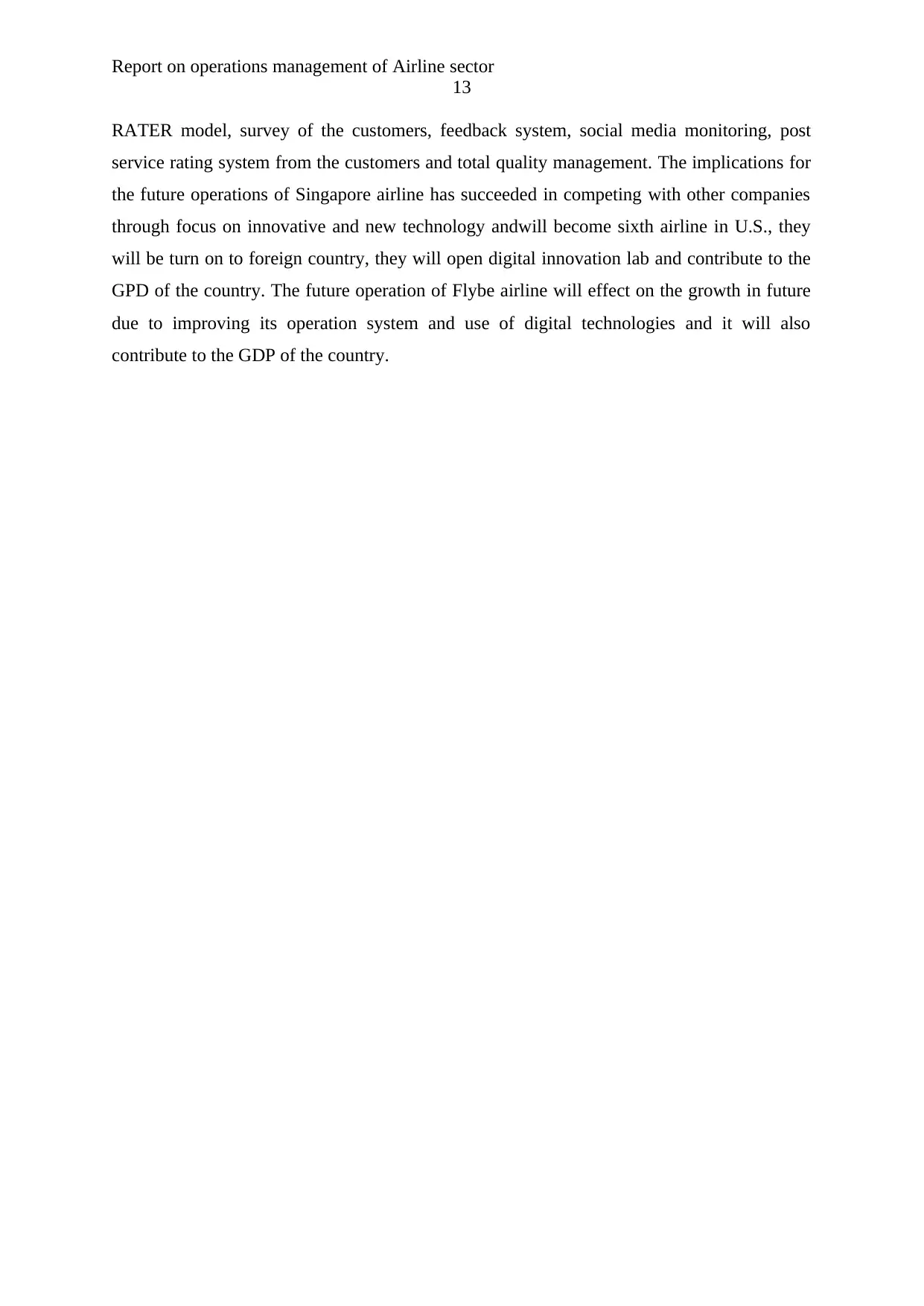
Report on operations management of Airline sector
13
RATER model, survey of the customers, feedback system, social media monitoring, post
service rating system from the customers and total quality management. The implications for
the future operations of Singapore airline has succeeded in competing with other companies
through focus on innovative and new technology andwill become sixth airline in U.S., they
will be turn on to foreign country, they will open digital innovation lab and contribute to the
GPD of the country. The future operation of Flybe airline will effect on the growth in future
due to improving its operation system and use of digital technologies and it will also
contribute to the GDP of the country.
13
RATER model, survey of the customers, feedback system, social media monitoring, post
service rating system from the customers and total quality management. The implications for
the future operations of Singapore airline has succeeded in competing with other companies
through focus on innovative and new technology andwill become sixth airline in U.S., they
will be turn on to foreign country, they will open digital innovation lab and contribute to the
GPD of the country. The future operation of Flybe airline will effect on the growth in future
due to improving its operation system and use of digital technologies and it will also
contribute to the GDP of the country.
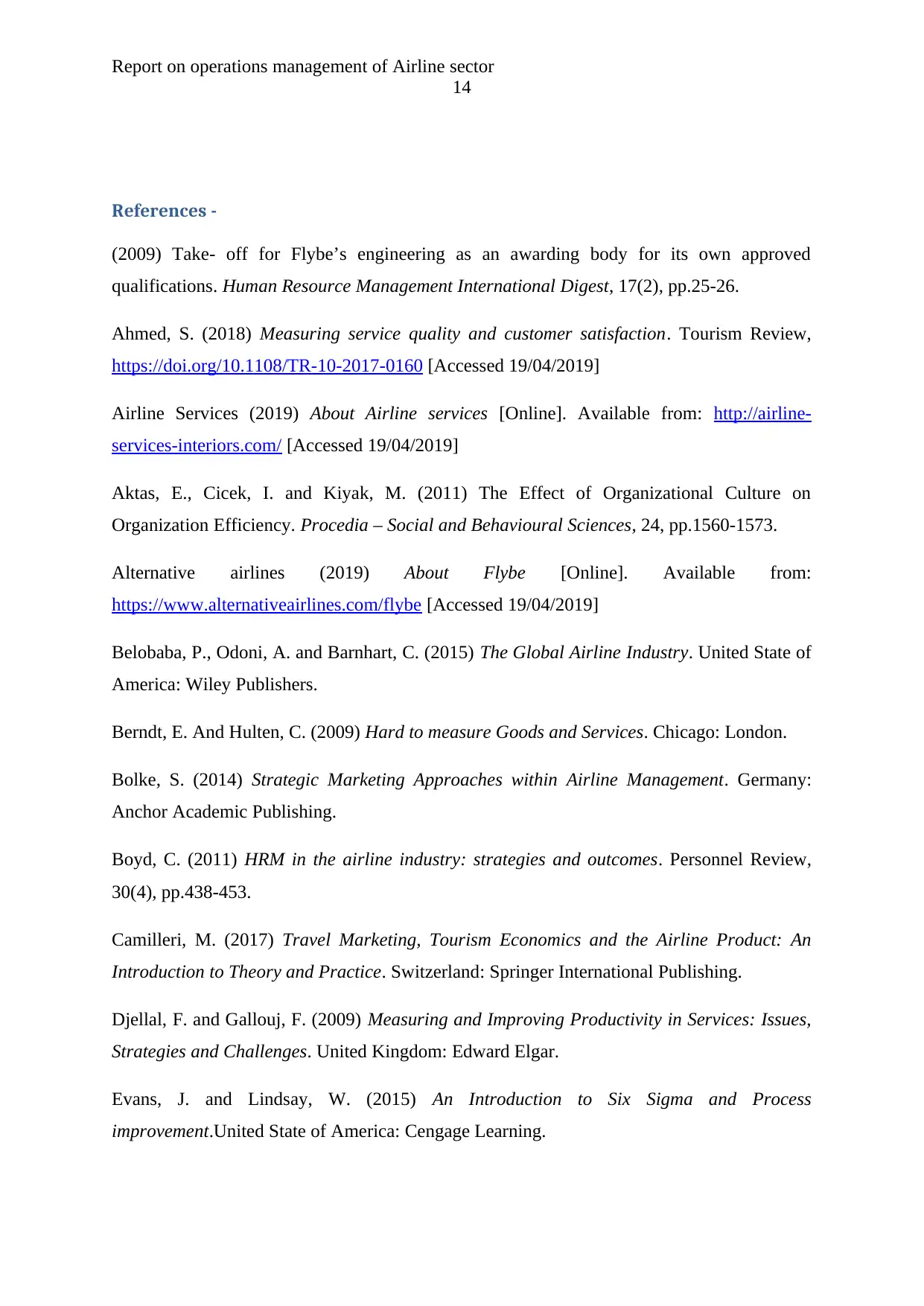
Report on operations management of Airline sector
14
References -
(2009) Take- off for Flybe’s engineering as an awarding body for its own approved
qualifications. Human Resource Management International Digest, 17(2), pp.25-26.
Ahmed, S. (2018) Measuring service quality and customer satisfaction. Tourism Review,
https://doi.org/10.1108/TR-10-2017-0160 [Accessed 19/04/2019]
Airline Services (2019) About Airline services [Online]. Available from: http://airline-
services-interiors.com/ [Accessed 19/04/2019]
Aktas, E., Cicek, I. and Kiyak, M. (2011) The Effect of Organizational Culture on
Organization Efficiency. Procedia – Social and Behavioural Sciences, 24, pp.1560-1573.
Alternative airlines (2019) About Flybe [Online]. Available from:
https://www.alternativeairlines.com/flybe [Accessed 19/04/2019]
Belobaba, P., Odoni, A. and Barnhart, C. (2015) The Global Airline Industry. United State of
America: Wiley Publishers.
Berndt, E. And Hulten, C. (2009) Hard to measure Goods and Services. Chicago: London.
Bolke, S. (2014) Strategic Marketing Approaches within Airline Management. Germany:
Anchor Academic Publishing.
Boyd, C. (2011) HRM in the airline industry: strategies and outcomes. Personnel Review,
30(4), pp.438-453.
Camilleri, M. (2017) Travel Marketing, Tourism Economics and the Airline Product: An
Introduction to Theory and Practice. Switzerland: Springer International Publishing.
Djellal, F. and Gallouj, F. (2009) Measuring and Improving Productivity in Services: Issues,
Strategies and Challenges. United Kingdom: Edward Elgar.
Evans, J. and Lindsay, W. (2015) An Introduction to Six Sigma and Process
improvement.United State of America: Cengage Learning.
14
References -
(2009) Take- off for Flybe’s engineering as an awarding body for its own approved
qualifications. Human Resource Management International Digest, 17(2), pp.25-26.
Ahmed, S. (2018) Measuring service quality and customer satisfaction. Tourism Review,
https://doi.org/10.1108/TR-10-2017-0160 [Accessed 19/04/2019]
Airline Services (2019) About Airline services [Online]. Available from: http://airline-
services-interiors.com/ [Accessed 19/04/2019]
Aktas, E., Cicek, I. and Kiyak, M. (2011) The Effect of Organizational Culture on
Organization Efficiency. Procedia – Social and Behavioural Sciences, 24, pp.1560-1573.
Alternative airlines (2019) About Flybe [Online]. Available from:
https://www.alternativeairlines.com/flybe [Accessed 19/04/2019]
Belobaba, P., Odoni, A. and Barnhart, C. (2015) The Global Airline Industry. United State of
America: Wiley Publishers.
Berndt, E. And Hulten, C. (2009) Hard to measure Goods and Services. Chicago: London.
Bolke, S. (2014) Strategic Marketing Approaches within Airline Management. Germany:
Anchor Academic Publishing.
Boyd, C. (2011) HRM in the airline industry: strategies and outcomes. Personnel Review,
30(4), pp.438-453.
Camilleri, M. (2017) Travel Marketing, Tourism Economics and the Airline Product: An
Introduction to Theory and Practice. Switzerland: Springer International Publishing.
Djellal, F. and Gallouj, F. (2009) Measuring and Improving Productivity in Services: Issues,
Strategies and Challenges. United Kingdom: Edward Elgar.
Evans, J. and Lindsay, W. (2015) An Introduction to Six Sigma and Process
improvement.United State of America: Cengage Learning.
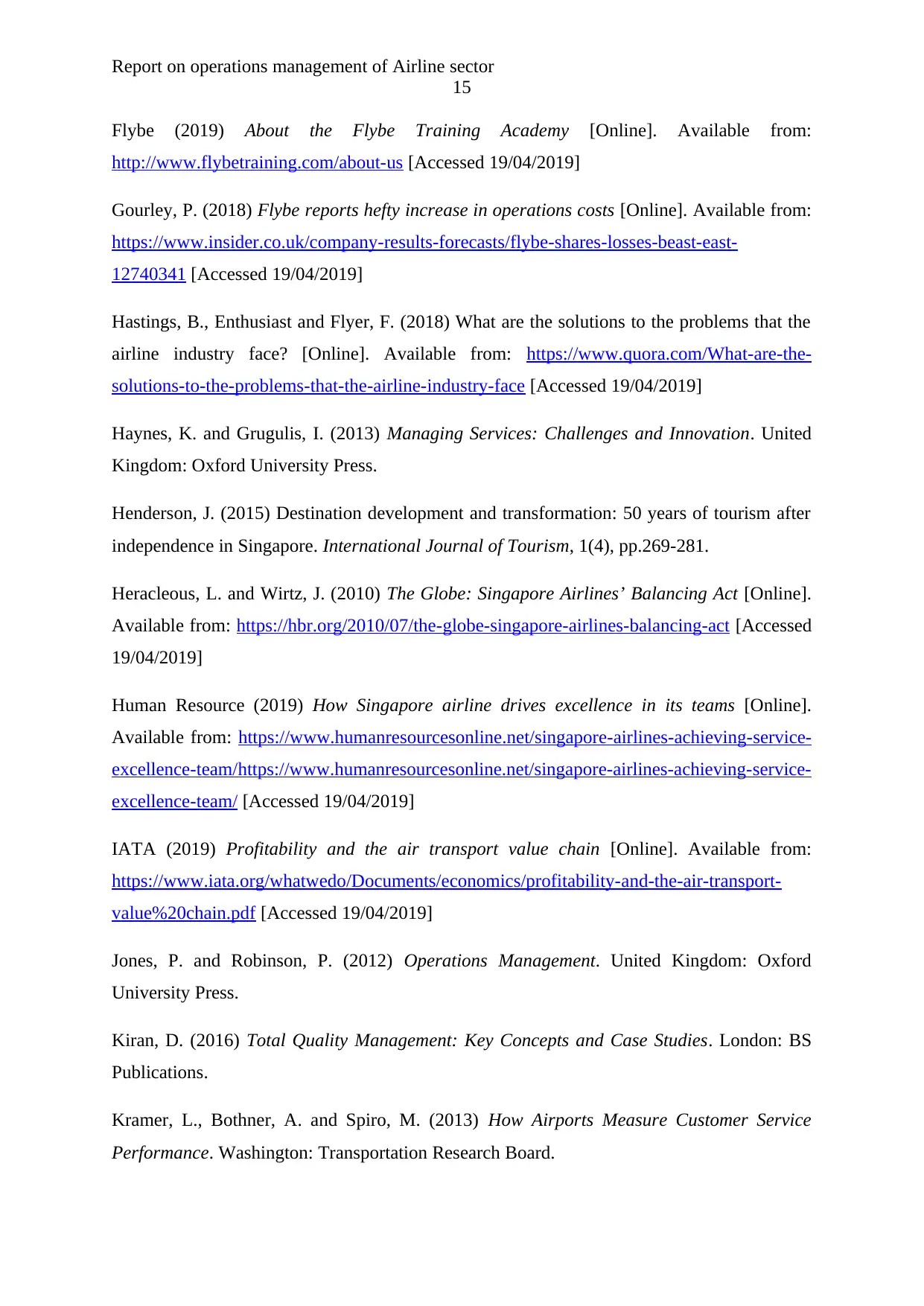
Report on operations management of Airline sector
15
Flybe (2019) About the Flybe Training Academy [Online]. Available from:
http://www.flybetraining.com/about-us [Accessed 19/04/2019]
Gourley, P. (2018) Flybe reports hefty increase in operations costs [Online]. Available from:
https://www.insider.co.uk/company-results-forecasts/flybe-shares-losses-beast-east-
12740341 [Accessed 19/04/2019]
Hastings, B., Enthusiast and Flyer, F. (2018) What are the solutions to the problems that the
airline industry face? [Online]. Available from: https://www.quora.com/What-are-the-
solutions-to-the-problems-that-the-airline-industry-face [Accessed 19/04/2019]
Haynes, K. and Grugulis, I. (2013) Managing Services: Challenges and Innovation. United
Kingdom: Oxford University Press.
Henderson, J. (2015) Destination development and transformation: 50 years of tourism after
independence in Singapore. International Journal of Tourism, 1(4), pp.269-281.
Heracleous, L. and Wirtz, J. (2010) The Globe: Singapore Airlines’ Balancing Act [Online].
Available from: https://hbr.org/2010/07/the-globe-singapore-airlines-balancing-act [Accessed
19/04/2019]
Human Resource (2019) How Singapore airline drives excellence in its teams [Online].
Available from: https://www.humanresourcesonline.net/singapore-airlines-achieving-service-
excellence-team/https://www.humanresourcesonline.net/singapore-airlines-achieving-service-
excellence-team/ [Accessed 19/04/2019]
IATA (2019) Profitability and the air transport value chain [Online]. Available from:
https://www.iata.org/whatwedo/Documents/economics/profitability-and-the-air-transport-
value%20chain.pdf [Accessed 19/04/2019]
Jones, P. and Robinson, P. (2012) Operations Management. United Kingdom: Oxford
University Press.
Kiran, D. (2016) Total Quality Management: Key Concepts and Case Studies. London: BS
Publications.
Kramer, L., Bothner, A. and Spiro, M. (2013) How Airports Measure Customer Service
Performance. Washington: Transportation Research Board.
15
Flybe (2019) About the Flybe Training Academy [Online]. Available from:
http://www.flybetraining.com/about-us [Accessed 19/04/2019]
Gourley, P. (2018) Flybe reports hefty increase in operations costs [Online]. Available from:
https://www.insider.co.uk/company-results-forecasts/flybe-shares-losses-beast-east-
12740341 [Accessed 19/04/2019]
Hastings, B., Enthusiast and Flyer, F. (2018) What are the solutions to the problems that the
airline industry face? [Online]. Available from: https://www.quora.com/What-are-the-
solutions-to-the-problems-that-the-airline-industry-face [Accessed 19/04/2019]
Haynes, K. and Grugulis, I. (2013) Managing Services: Challenges and Innovation. United
Kingdom: Oxford University Press.
Henderson, J. (2015) Destination development and transformation: 50 years of tourism after
independence in Singapore. International Journal of Tourism, 1(4), pp.269-281.
Heracleous, L. and Wirtz, J. (2010) The Globe: Singapore Airlines’ Balancing Act [Online].
Available from: https://hbr.org/2010/07/the-globe-singapore-airlines-balancing-act [Accessed
19/04/2019]
Human Resource (2019) How Singapore airline drives excellence in its teams [Online].
Available from: https://www.humanresourcesonline.net/singapore-airlines-achieving-service-
excellence-team/https://www.humanresourcesonline.net/singapore-airlines-achieving-service-
excellence-team/ [Accessed 19/04/2019]
IATA (2019) Profitability and the air transport value chain [Online]. Available from:
https://www.iata.org/whatwedo/Documents/economics/profitability-and-the-air-transport-
value%20chain.pdf [Accessed 19/04/2019]
Jones, P. and Robinson, P. (2012) Operations Management. United Kingdom: Oxford
University Press.
Kiran, D. (2016) Total Quality Management: Key Concepts and Case Studies. London: BS
Publications.
Kramer, L., Bothner, A. and Spiro, M. (2013) How Airports Measure Customer Service
Performance. Washington: Transportation Research Board.
Secure Best Marks with AI Grader
Need help grading? Try our AI Grader for instant feedback on your assignments.
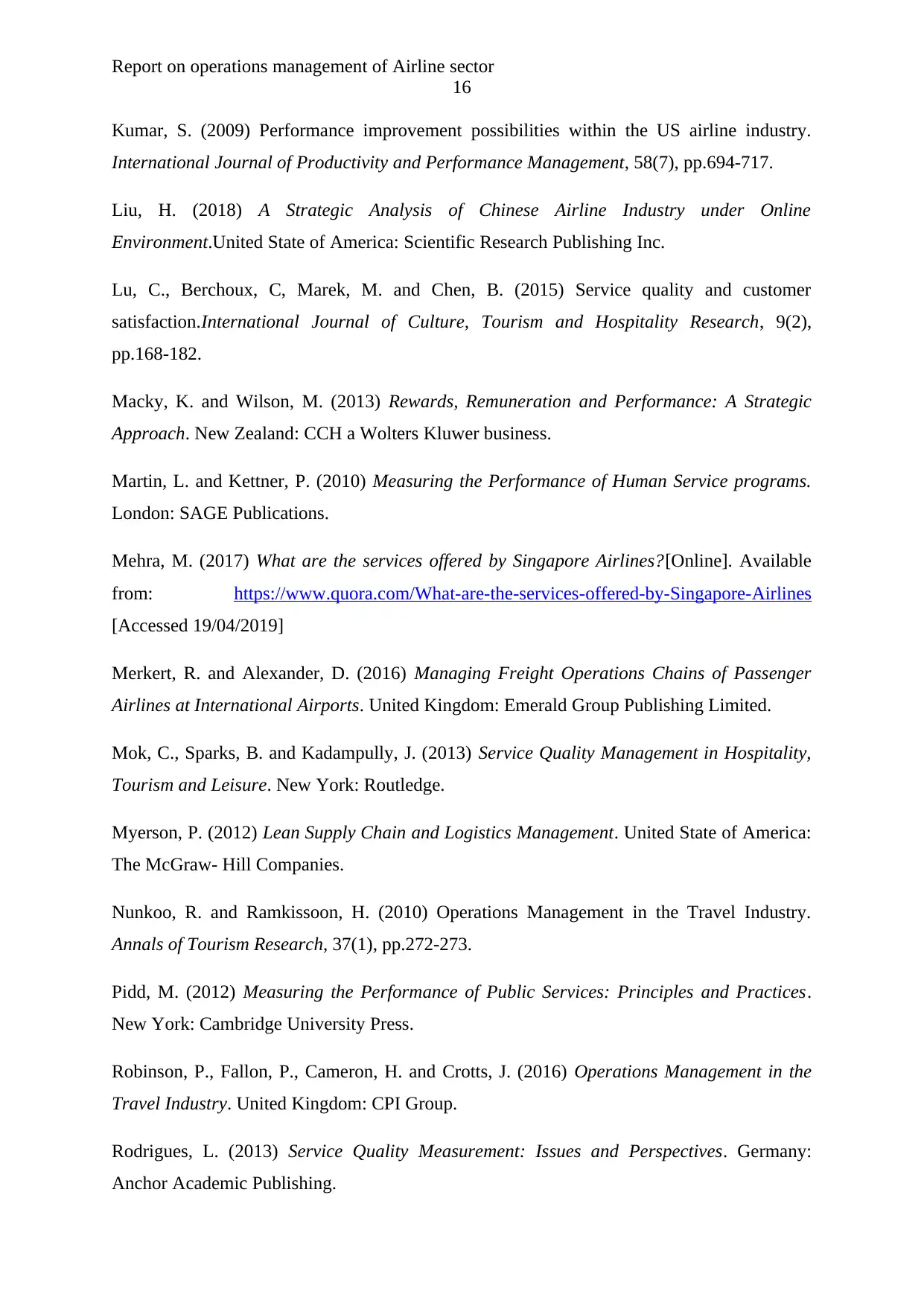
Report on operations management of Airline sector
16
Kumar, S. (2009) Performance improvement possibilities within the US airline industry.
International Journal of Productivity and Performance Management, 58(7), pp.694-717.
Liu, H. (2018) A Strategic Analysis of Chinese Airline Industry under Online
Environment.United State of America: Scientific Research Publishing Inc.
Lu, C., Berchoux, C, Marek, M. and Chen, B. (2015) Service quality and customer
satisfaction.International Journal of Culture, Tourism and Hospitality Research, 9(2),
pp.168-182.
Macky, K. and Wilson, M. (2013) Rewards, Remuneration and Performance: A Strategic
Approach. New Zealand: CCH a Wolters Kluwer business.
Martin, L. and Kettner, P. (2010) Measuring the Performance of Human Service programs.
London: SAGE Publications.
Mehra, M. (2017) What are the services offered by Singapore Airlines?[Online]. Available
from: https://www.quora.com/What-are-the-services-offered-by-Singapore-Airlines
[Accessed 19/04/2019]
Merkert, R. and Alexander, D. (2016) Managing Freight Operations Chains of Passenger
Airlines at International Airports. United Kingdom: Emerald Group Publishing Limited.
Mok, C., Sparks, B. and Kadampully, J. (2013) Service Quality Management in Hospitality,
Tourism and Leisure. New York: Routledge.
Myerson, P. (2012) Lean Supply Chain and Logistics Management. United State of America:
The McGraw- Hill Companies.
Nunkoo, R. and Ramkissoon, H. (2010) Operations Management in the Travel Industry.
Annals of Tourism Research, 37(1), pp.272-273.
Pidd, M. (2012) Measuring the Performance of Public Services: Principles and Practices.
New York: Cambridge University Press.
Robinson, P., Fallon, P., Cameron, H. and Crotts, J. (2016) Operations Management in the
Travel Industry. United Kingdom: CPI Group.
Rodrigues, L. (2013) Service Quality Measurement: Issues and Perspectives. Germany:
Anchor Academic Publishing.
16
Kumar, S. (2009) Performance improvement possibilities within the US airline industry.
International Journal of Productivity and Performance Management, 58(7), pp.694-717.
Liu, H. (2018) A Strategic Analysis of Chinese Airline Industry under Online
Environment.United State of America: Scientific Research Publishing Inc.
Lu, C., Berchoux, C, Marek, M. and Chen, B. (2015) Service quality and customer
satisfaction.International Journal of Culture, Tourism and Hospitality Research, 9(2),
pp.168-182.
Macky, K. and Wilson, M. (2013) Rewards, Remuneration and Performance: A Strategic
Approach. New Zealand: CCH a Wolters Kluwer business.
Martin, L. and Kettner, P. (2010) Measuring the Performance of Human Service programs.
London: SAGE Publications.
Mehra, M. (2017) What are the services offered by Singapore Airlines?[Online]. Available
from: https://www.quora.com/What-are-the-services-offered-by-Singapore-Airlines
[Accessed 19/04/2019]
Merkert, R. and Alexander, D. (2016) Managing Freight Operations Chains of Passenger
Airlines at International Airports. United Kingdom: Emerald Group Publishing Limited.
Mok, C., Sparks, B. and Kadampully, J. (2013) Service Quality Management in Hospitality,
Tourism and Leisure. New York: Routledge.
Myerson, P. (2012) Lean Supply Chain and Logistics Management. United State of America:
The McGraw- Hill Companies.
Nunkoo, R. and Ramkissoon, H. (2010) Operations Management in the Travel Industry.
Annals of Tourism Research, 37(1), pp.272-273.
Pidd, M. (2012) Measuring the Performance of Public Services: Principles and Practices.
New York: Cambridge University Press.
Robinson, P., Fallon, P., Cameron, H. and Crotts, J. (2016) Operations Management in the
Travel Industry. United Kingdom: CPI Group.
Rodrigues, L. (2013) Service Quality Measurement: Issues and Perspectives. Germany:
Anchor Academic Publishing.
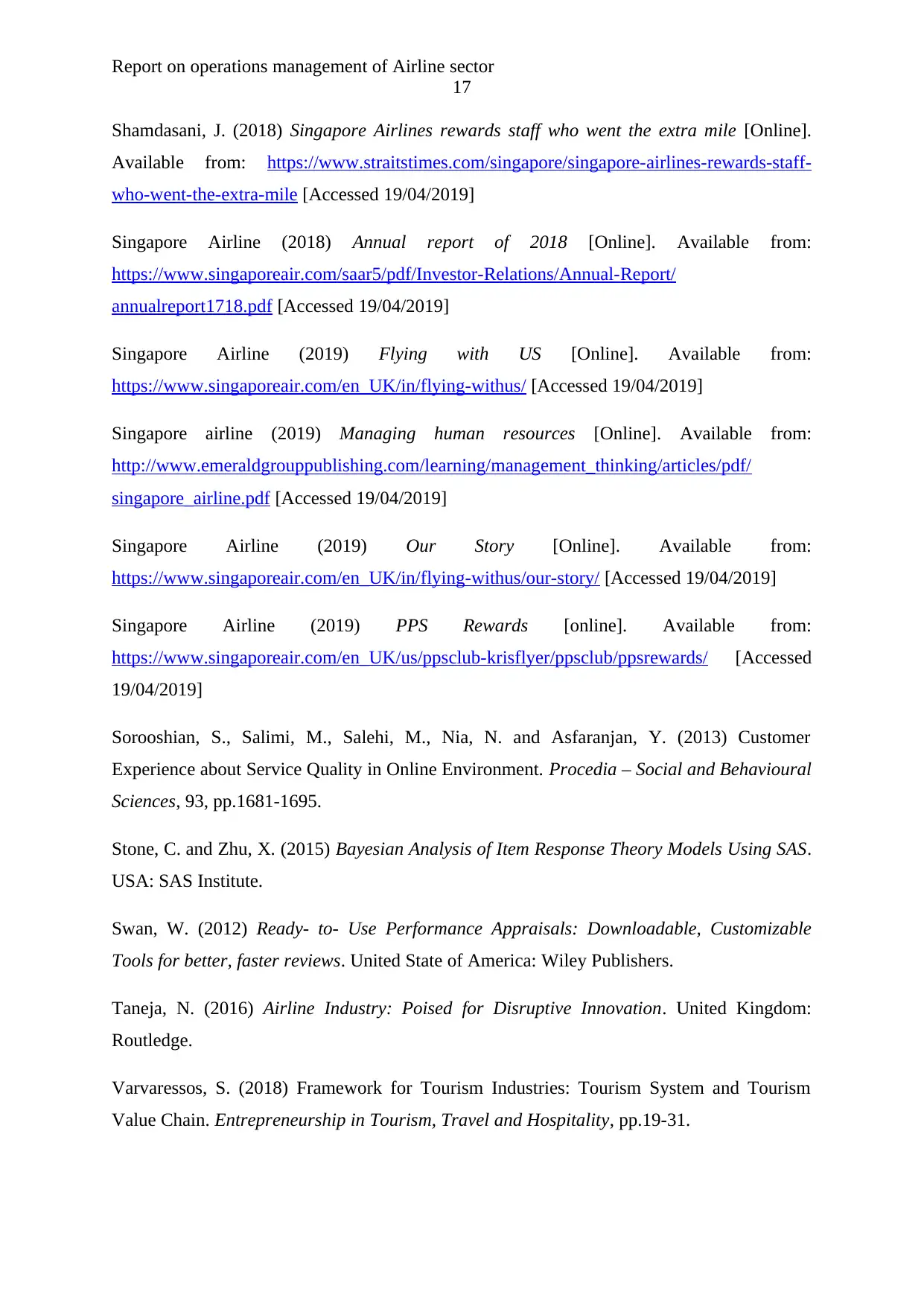
Report on operations management of Airline sector
17
Shamdasani, J. (2018) Singapore Airlines rewards staff who went the extra mile [Online].
Available from: https://www.straitstimes.com/singapore/singapore-airlines-rewards-staff-
who-went-the-extra-mile [Accessed 19/04/2019]
Singapore Airline (2018) Annual report of 2018 [Online]. Available from:
https://www.singaporeair.com/saar5/pdf/Investor-Relations/Annual-Report/
annualreport1718.pdf [Accessed 19/04/2019]
Singapore Airline (2019) Flying with US [Online]. Available from:
https://www.singaporeair.com/en_UK/in/flying-withus/ [Accessed 19/04/2019]
Singapore airline (2019) Managing human resources [Online]. Available from:
http://www.emeraldgrouppublishing.com/learning/management_thinking/articles/pdf/
singapore_airline.pdf [Accessed 19/04/2019]
Singapore Airline (2019) Our Story [Online]. Available from:
https://www.singaporeair.com/en_UK/in/flying-withus/our-story/ [Accessed 19/04/2019]
Singapore Airline (2019) PPS Rewards [online]. Available from:
https://www.singaporeair.com/en_UK/us/ppsclub-krisflyer/ppsclub/ppsrewards/ [Accessed
19/04/2019]
Sorooshian, S., Salimi, M., Salehi, M., Nia, N. and Asfaranjan, Y. (2013) Customer
Experience about Service Quality in Online Environment. Procedia – Social and Behavioural
Sciences, 93, pp.1681-1695.
Stone, C. and Zhu, X. (2015) Bayesian Analysis of Item Response Theory Models Using SAS.
USA: SAS Institute.
Swan, W. (2012) Ready- to- Use Performance Appraisals: Downloadable, Customizable
Tools for better, faster reviews. United State of America: Wiley Publishers.
Taneja, N. (2016) Airline Industry: Poised for Disruptive Innovation. United Kingdom:
Routledge.
Varvaressos, S. (2018) Framework for Tourism Industries: Tourism System and Tourism
Value Chain. Entrepreneurship in Tourism, Travel and Hospitality, pp.19-31.
17
Shamdasani, J. (2018) Singapore Airlines rewards staff who went the extra mile [Online].
Available from: https://www.straitstimes.com/singapore/singapore-airlines-rewards-staff-
who-went-the-extra-mile [Accessed 19/04/2019]
Singapore Airline (2018) Annual report of 2018 [Online]. Available from:
https://www.singaporeair.com/saar5/pdf/Investor-Relations/Annual-Report/
annualreport1718.pdf [Accessed 19/04/2019]
Singapore Airline (2019) Flying with US [Online]. Available from:
https://www.singaporeair.com/en_UK/in/flying-withus/ [Accessed 19/04/2019]
Singapore airline (2019) Managing human resources [Online]. Available from:
http://www.emeraldgrouppublishing.com/learning/management_thinking/articles/pdf/
singapore_airline.pdf [Accessed 19/04/2019]
Singapore Airline (2019) Our Story [Online]. Available from:
https://www.singaporeair.com/en_UK/in/flying-withus/our-story/ [Accessed 19/04/2019]
Singapore Airline (2019) PPS Rewards [online]. Available from:
https://www.singaporeair.com/en_UK/us/ppsclub-krisflyer/ppsclub/ppsrewards/ [Accessed
19/04/2019]
Sorooshian, S., Salimi, M., Salehi, M., Nia, N. and Asfaranjan, Y. (2013) Customer
Experience about Service Quality in Online Environment. Procedia – Social and Behavioural
Sciences, 93, pp.1681-1695.
Stone, C. and Zhu, X. (2015) Bayesian Analysis of Item Response Theory Models Using SAS.
USA: SAS Institute.
Swan, W. (2012) Ready- to- Use Performance Appraisals: Downloadable, Customizable
Tools for better, faster reviews. United State of America: Wiley Publishers.
Taneja, N. (2016) Airline Industry: Poised for Disruptive Innovation. United Kingdom:
Routledge.
Varvaressos, S. (2018) Framework for Tourism Industries: Tourism System and Tourism
Value Chain. Entrepreneurship in Tourism, Travel and Hospitality, pp.19-31.
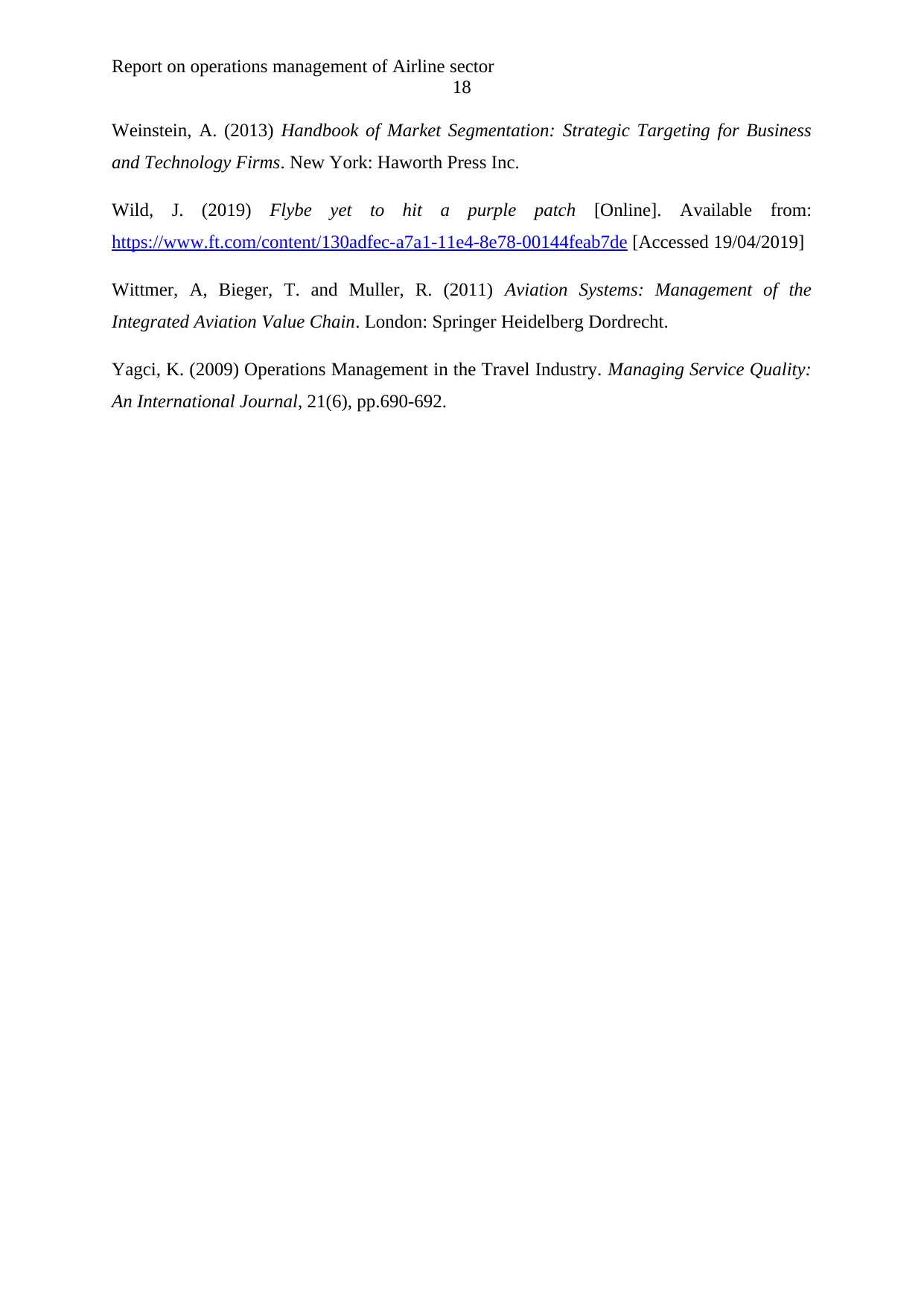
Report on operations management of Airline sector
18
Weinstein, A. (2013) Handbook of Market Segmentation: Strategic Targeting for Business
and Technology Firms. New York: Haworth Press Inc.
Wild, J. (2019) Flybe yet to hit a purple patch [Online]. Available from:
https://www.ft.com/content/130adfec-a7a1-11e4-8e78-00144feab7de [Accessed 19/04/2019]
Wittmer, A, Bieger, T. and Muller, R. (2011) Aviation Systems: Management of the
Integrated Aviation Value Chain. London: Springer Heidelberg Dordrecht.
Yagci, K. (2009) Operations Management in the Travel Industry. Managing Service Quality:
An International Journal, 21(6), pp.690-692.
18
Weinstein, A. (2013) Handbook of Market Segmentation: Strategic Targeting for Business
and Technology Firms. New York: Haworth Press Inc.
Wild, J. (2019) Flybe yet to hit a purple patch [Online]. Available from:
https://www.ft.com/content/130adfec-a7a1-11e4-8e78-00144feab7de [Accessed 19/04/2019]
Wittmer, A, Bieger, T. and Muller, R. (2011) Aviation Systems: Management of the
Integrated Aviation Value Chain. London: Springer Heidelberg Dordrecht.
Yagci, K. (2009) Operations Management in the Travel Industry. Managing Service Quality:
An International Journal, 21(6), pp.690-692.
1 out of 19
Related Documents
Your All-in-One AI-Powered Toolkit for Academic Success.
+13062052269
info@desklib.com
Available 24*7 on WhatsApp / Email
![[object Object]](/_next/static/media/star-bottom.7253800d.svg)
Unlock your academic potential
© 2024 | Zucol Services PVT LTD | All rights reserved.




